Upon arriving in Bangkok, I first settled into the hotel and rested a bit more as my cold still lingered. After some time, however, I was ready to take a short walk around. I went to the nearby Wat Traimit temple, which houses the Golden Buddha.
I had already seen this temple at the beginning of my stay in Thailand when I was exploring Chinatown with my friend Raša. At that time, we didn’t do a detailed sightseeing, but rather Raša was showing me different places and we only occasionally entered somewhere. Still, he did emphasise that this was an important temple, so I had intended to visit it at the end of my stay in Thailand.
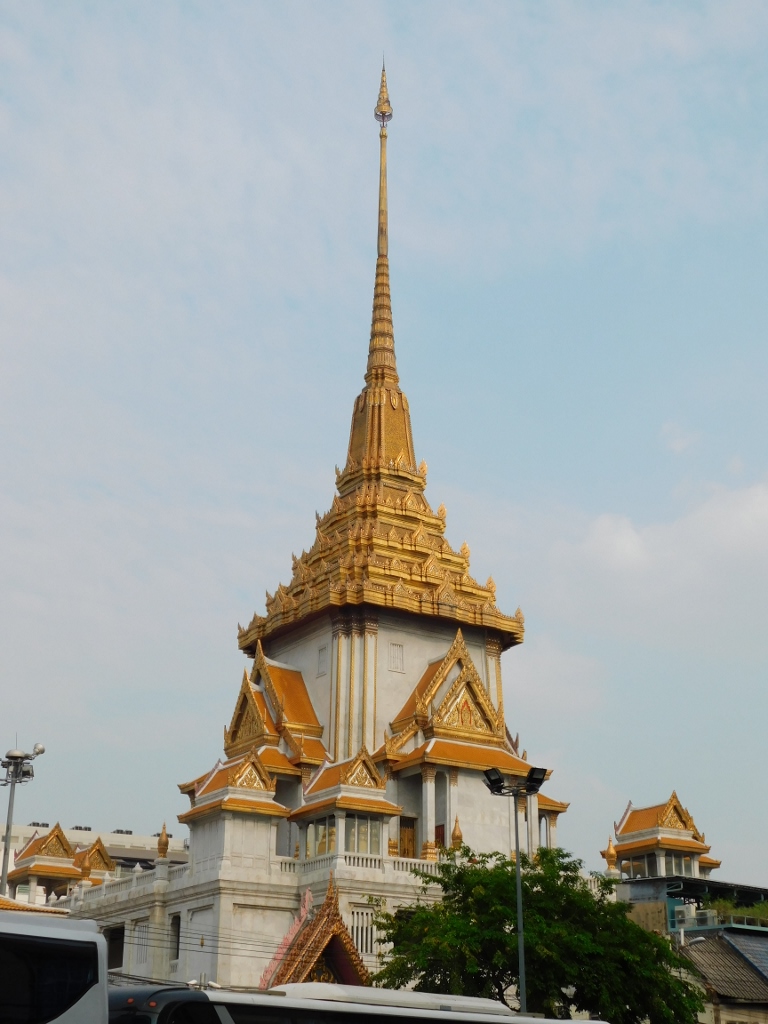 Wat Traimit
Wat Traimit
 Wat Traimit
Wat Traimit
Now I went there and the story is very interesting.
Although there is an opinion that the temple was founded in the early 13th century, the completely new and modern part of the temple seen in the photo above houses the Golden Buddha. This Buddha figure is not only called “golden,” it is truly made of pure gold, standing 3 metres tall and weighing 5 and a half tons!!!
The figure is sculpted in the Sukhothai style and it is presumed to have been made at the end of the Sukhothai period or during the existence of the Ayutthaya Kingdom. However, what is particularly interesting is that it was actually covered with plaster for centuries, presumably to protect it from Burmese invaders who were inclined to take away gold statues. And so it remained like this until the beginning of the second half of the 20th century when, during the relocation of the figure, supposedly made of plaster, within the temple, it detached from the crane and fell. On that occasion, a part of the external plaster came off, revealing the gold. After that, the figure was restored and placed in the temple, where it can still be seen today.
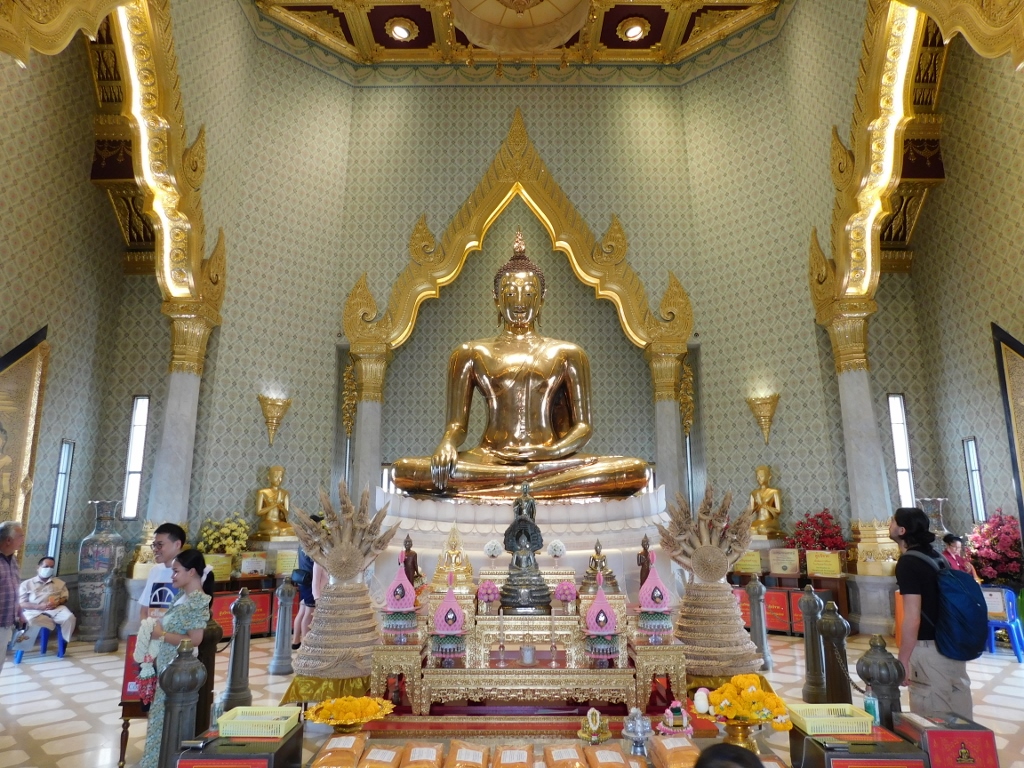 Golden Buddha
Golden Buddha
After visiting the temple and the Golden Buddha, I stepped out onto the street and continued to stroll through Chinatown, without any specific goal. Along the way, I saw various buildings and one was particularly interesting and beautiful – it reflected the past, the passage of time, the present and surely hides countless stories about the fate of people who used it and those who still use it today.
 Chinatown, a detail
Chinatown, a detail
Then I realized I could grab something to eat, which is never really a problem anywhere in Thailand, especially not in Chinatown. So, I stopped at a place where the dish I ordered seemed like a delightful blend of Thai and Chinese flavours.
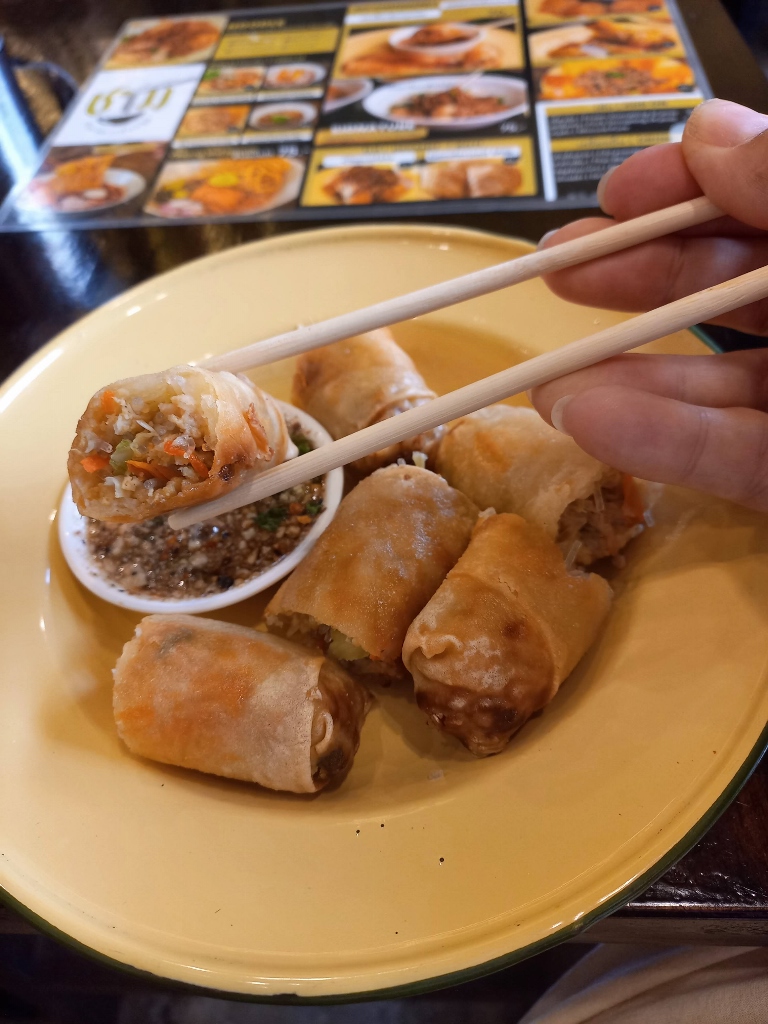 Pork and prawn spring rolls
Pork and prawn spring rolls
It seemed like food was being prepared everywhere in the quarter and I stopped at a couple of places to take photos. However, on this day, I retired to my hotel room early because I wanted to rest as much as possible to recover and strengthen my body. I largely succeeded in doing so.
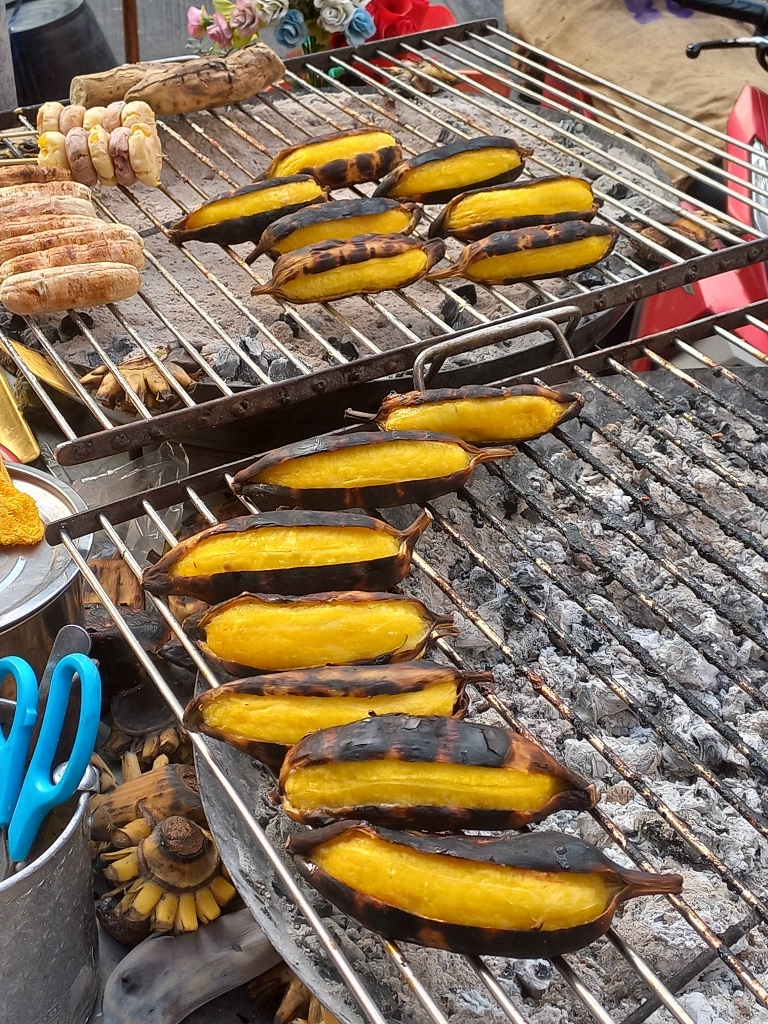 Street food in Chinatown, a detail
Street food in Chinatown, a detail
The next day was the last full day I spent in Bangkok and I decided to visit an extremely important temple that I didn’t have the chance to see during my first stay in this impressive city. The temple’s official abbreviated name is Wat Phra Chetuphon, but it is more commonly known by its shortest name – Wat Pho.
Considering that the humidity was now consistently high and the morning temperature was higher than at the beginning of my stay in Thailand, I decided to go to the temple early in the morning. I believe it was a very good decision, regardless of the weather conditions and the time of year. This is a very popular place among visitors and I think it is advisable to arrive early (the temple opens at 8 a.m.) to see everything without too much crowding. Due to the early hour, the otherwise busy street where my hotel was located was quite peaceful.
 Chinatown, a detail
Chinatown, a detail
To start with, I went from Chinatown to the vicinity of Wat Pho by underground. To tell the truth, I felt like taking that mode of transportation as well. By the way, Bangkok also has a very distinctive elevated metro system (Skytrain), but I neither had the time nor the need to try it since it wasn’t convenient for my sightseeing. After all, I’m not a traffic engineer exploring public transportation in Bangkok and Thailand. The reason I still relatively often mention the various vehicles I used is more a reflection of my fascination with the diversity and variety of transportation means that were simply practical for my journey.
As for the underground system, it was impressive, but since I started early, it was quite deserted. On the way back, there were more people, but by then, I lost the inspiration to take photos.
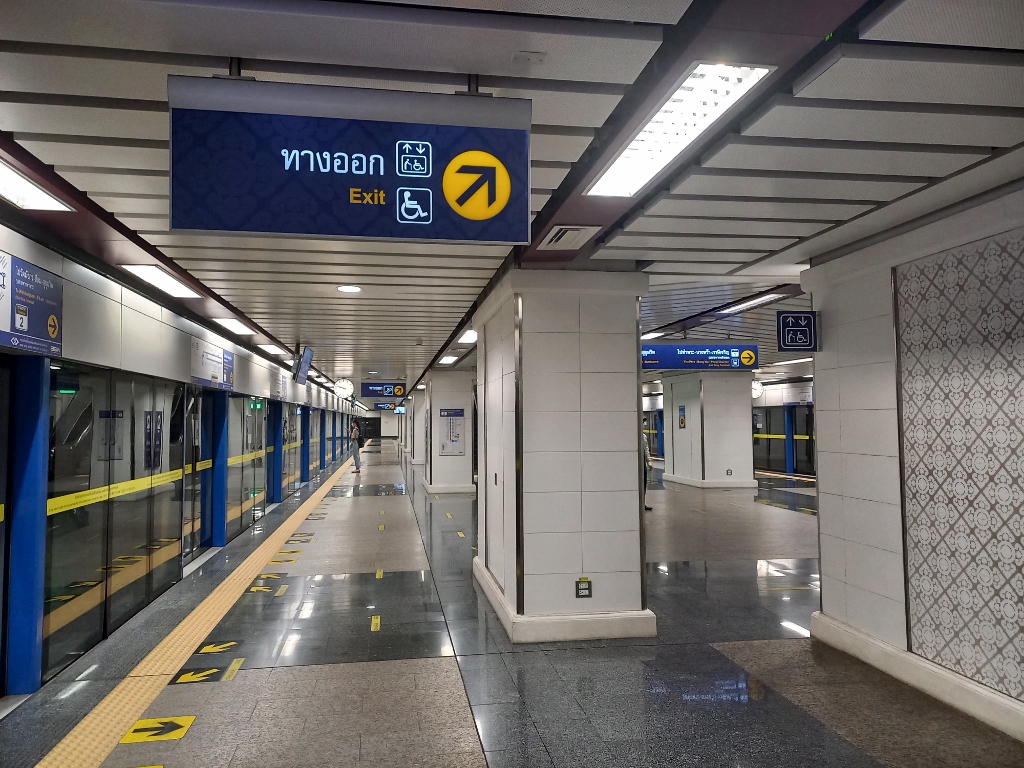 Bangkok underground station
Bangkok underground station
As for Wat Pho, it is located directly south of the Grand Palace, occupying quite a large area of about 8 hectares. Founded in the 16th century during the existence of the Ayutthaya Kingdom, it is practically the oldest temple in the city. It was also the first centre for public education in the country.
When I arrived here, I first entered a spacious courtyard surrounding the rectangular central courtyard with the ubosot, which has viharas and “inter-courtyards” on all four sides. This central part is enclosed by a high wall and there are numerous chedis around it. These main parts can be seen in the next photo.
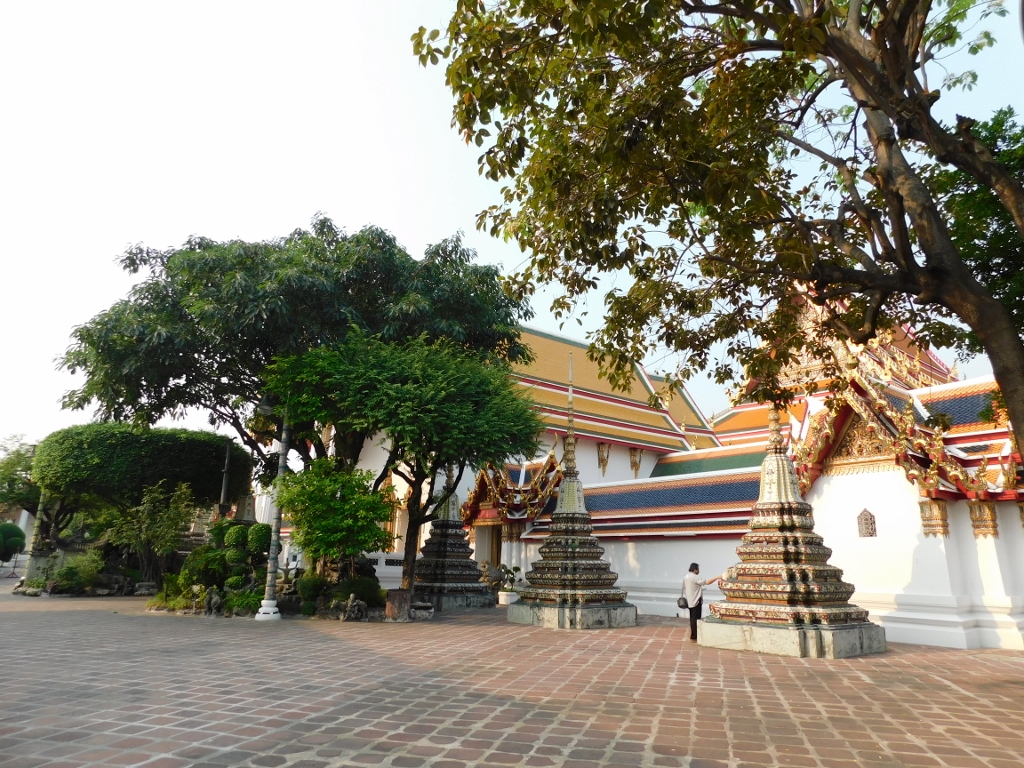 Wat Pho: in the middle, behind the trees, there is the east vihara, to the right behind the tree top you can discern the roof of the ubosot and also on the right-hand side there is the wall and several chedis
Wat Pho: in the middle, behind the trees, there is the east vihara, to the right behind the tree top you can discern the roof of the ubosot and also on the right-hand side there is the wall and several chedis
I first took photos of some of the chedis and the wall surrounding the inner courtyard, then I went to a door leading further into the central part of the temple, where the morning sun added brilliance to the abundance of golden details.
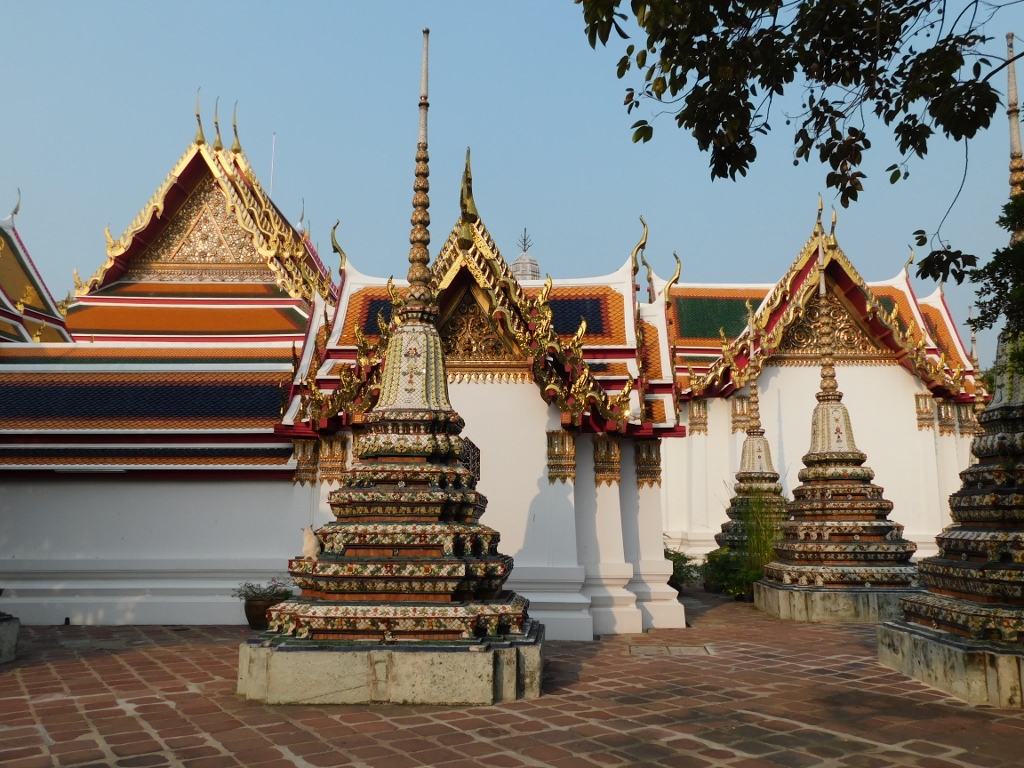 Wat Pho, a detail
Wat Pho, a detail
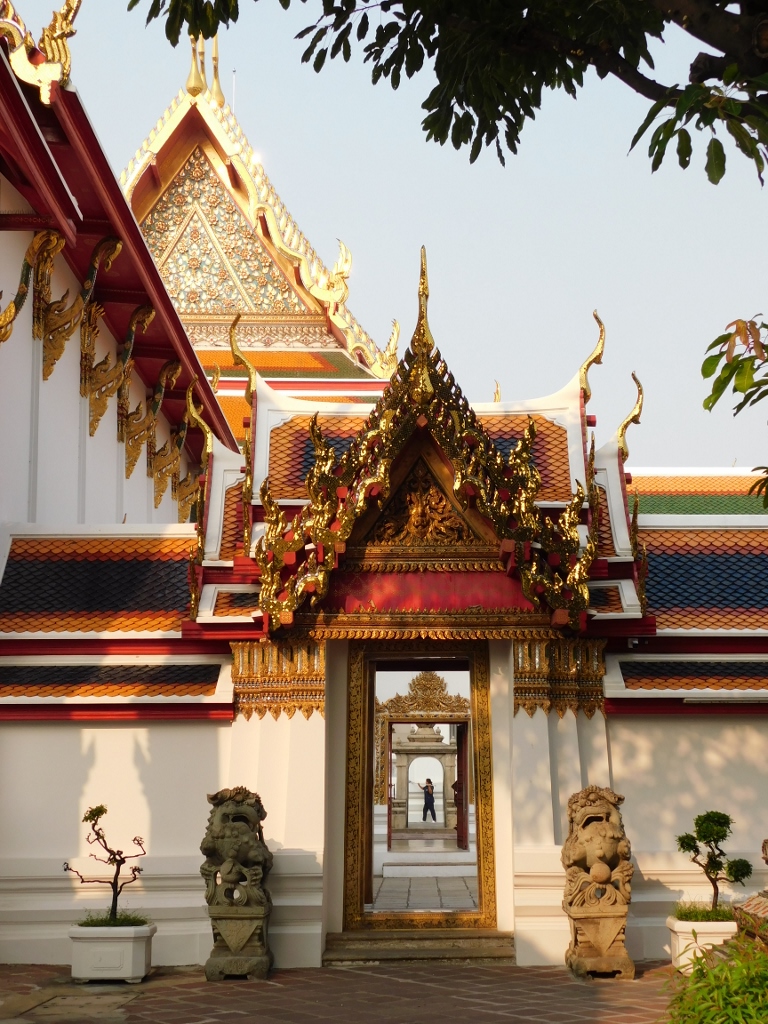 Wat Pho, a detail
Wat Pho, a detail
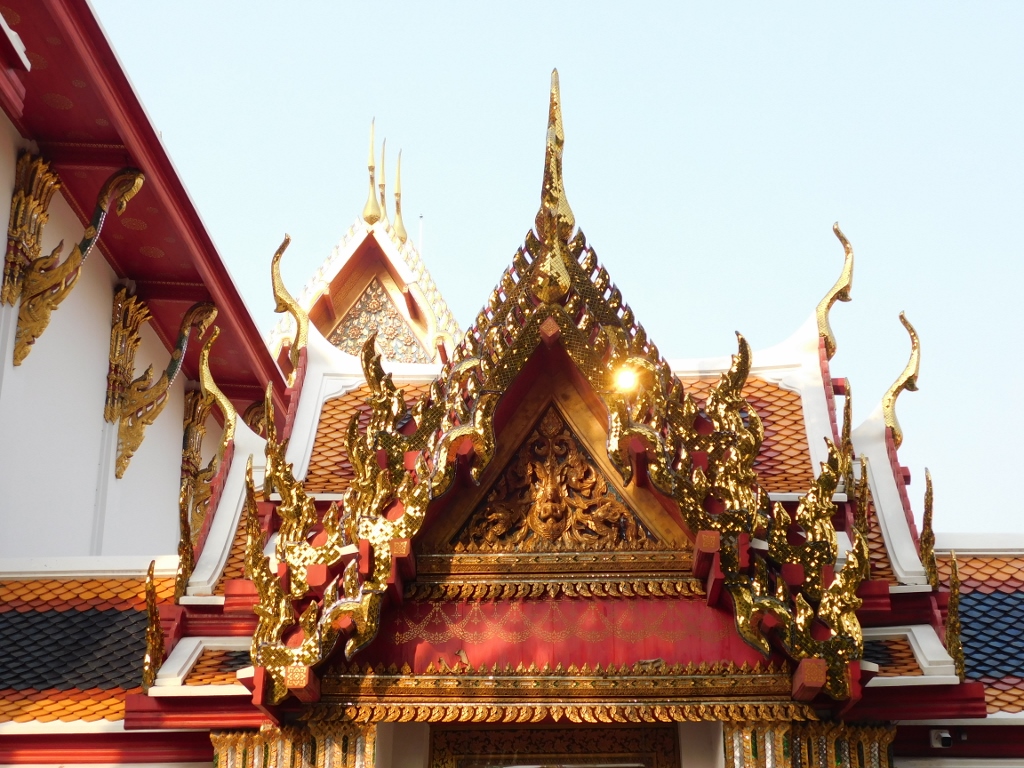 Wat Pho, a detail
Wat Pho, a detail
There, I first entered one of the “inter-courtyards” where I saw, among other things, several stone pagodas and figures that clearly reflect Chinese influence. Interestingly, these stone sculptures were originally used as ballast on ships engaged in trade with China, while today, they can be seen here as decorations in these “inter-courtyards.”
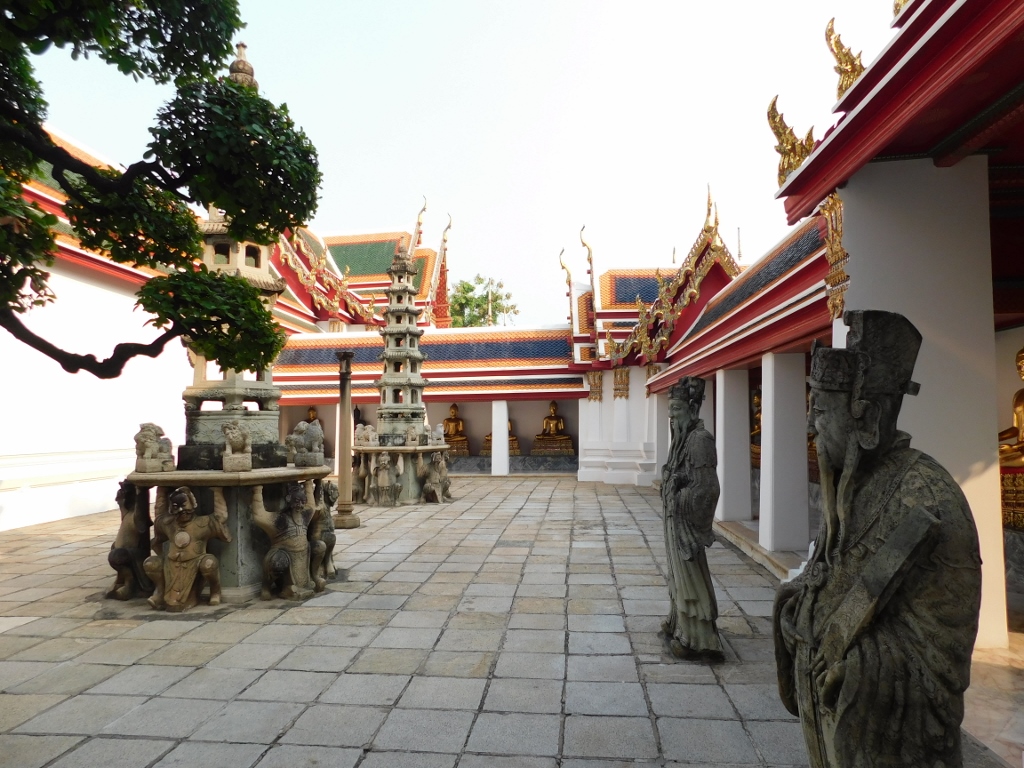 Wat Pho, a detail
Wat Pho, a detail
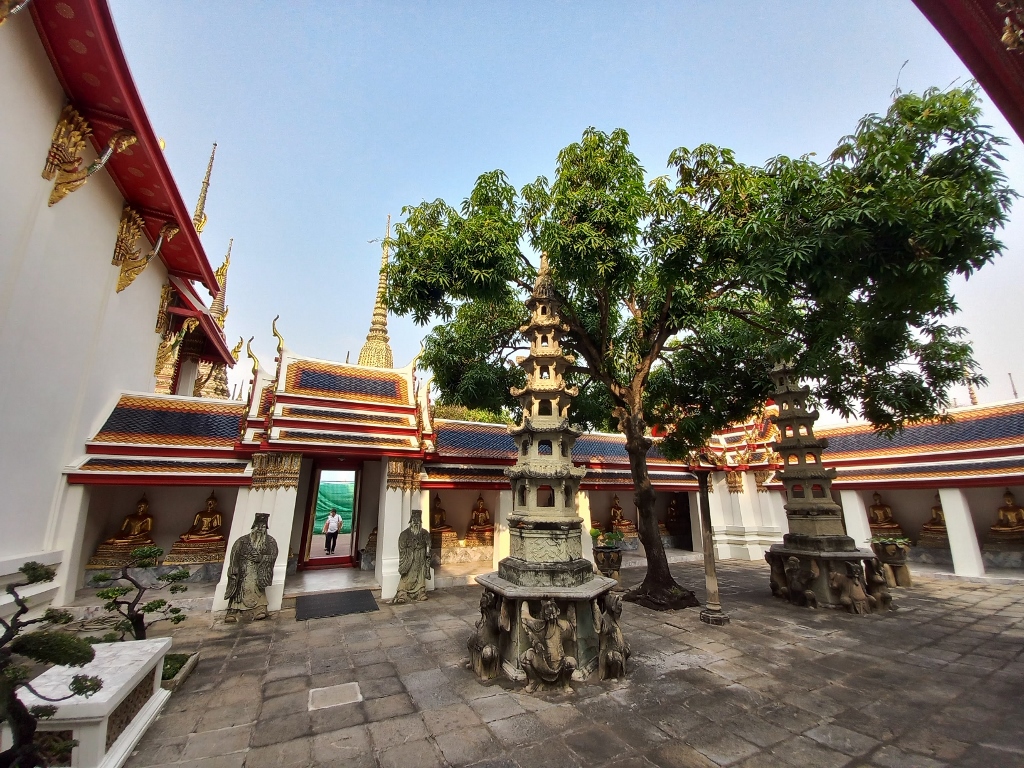 Wat Pho, a detail
Wat Pho, a detail
Since Wat Pho also houses the largest collection of Buddha figures, over 1000 of them, many can be seen adorning the galleries around all these courtyards, including the central one where the ubosot is located.
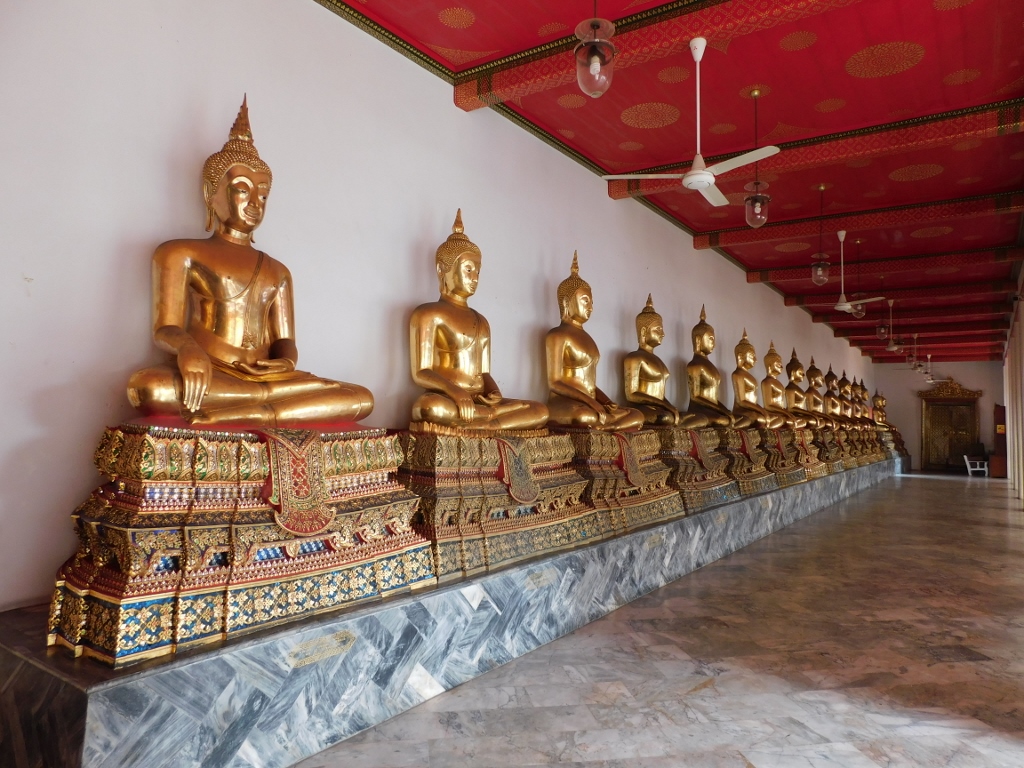 Wat Pho, a detail
Wat Pho, a detail
In that central courtyard where the ubosot is located, chedis are placed at the corners and they are, for some reason, referred to as stupas on the map inside the temple. As I’ve mentioned earlier, from what I could gather, the difference between these two terms essentially lies in the fact that “stupa” is the term used in India, while in Thailand, “chedi” should be the appropriate term. However, both terms are used here, while surely, true connoisseurs of Buddhism, which I certainly am not, know the distinction. By the way, one of my guidebooks also uses the term “prang” for them.
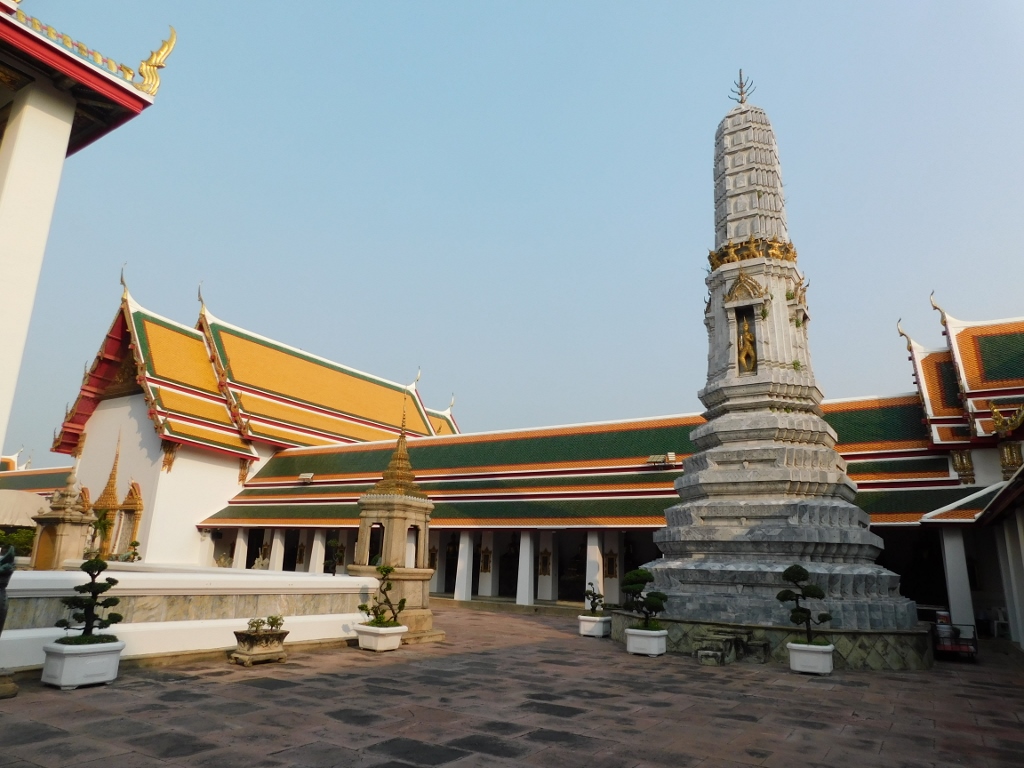 Wat Pho, a detail
Wat Pho, a detail
Still, before I went to visit the ubosot, I first noted the eastern vihara, where the large figure of the Standing Buddha, 8 m high, is located.
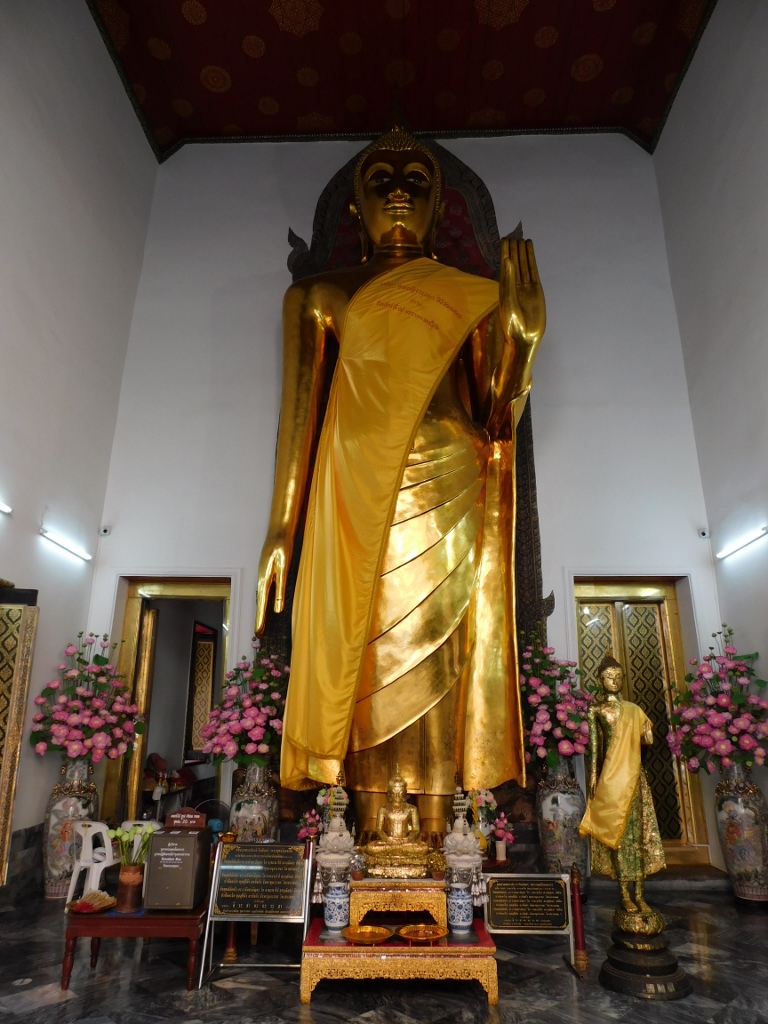 Wat Pho, Standing Buddha in the east vihara
Wat Pho, Standing Buddha in the east vihara
But, the most sacred building within the temple is undoubtedly the ubosot.
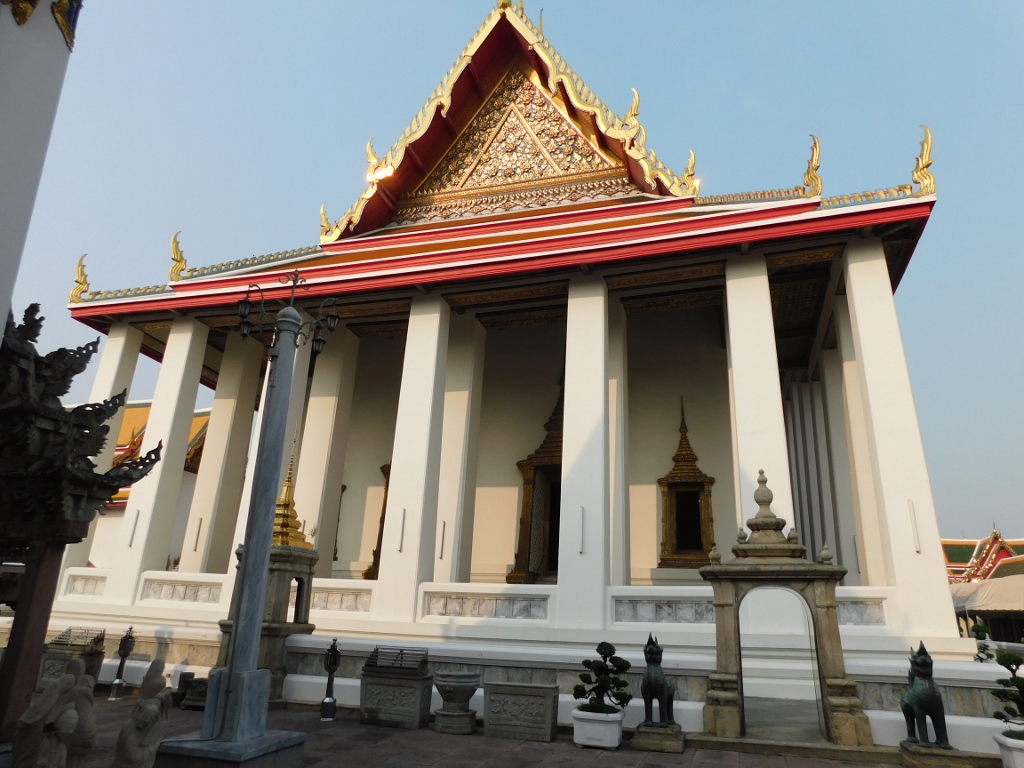 Wat Pho, ubosot
Wat Pho, ubosot
Inside, a large pedestal dominates, on top of which sits a gilded Buddha beneath a nine-tiered umbrella, representing the most sacred royal regalia of Thailand. I’ve already mentioned before that the nine tiers symbolise the Thai king himself, adding special significance to this temple.
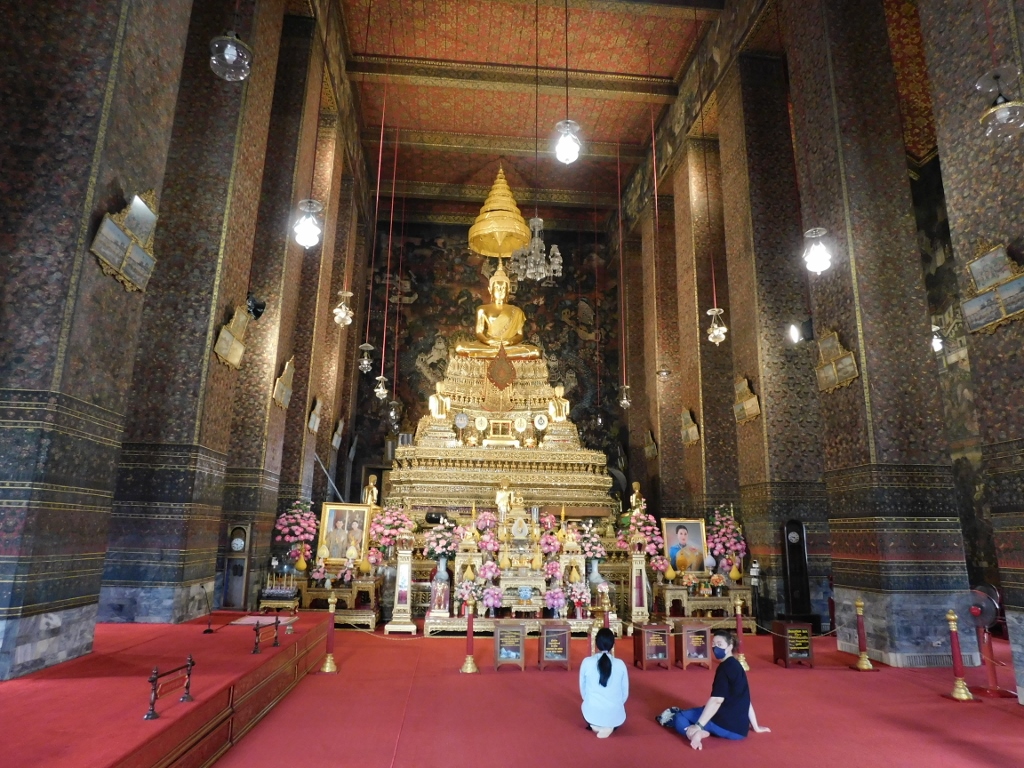 Wat Pho, the interior of the ubosot
Wat Pho, the interior of the ubosot
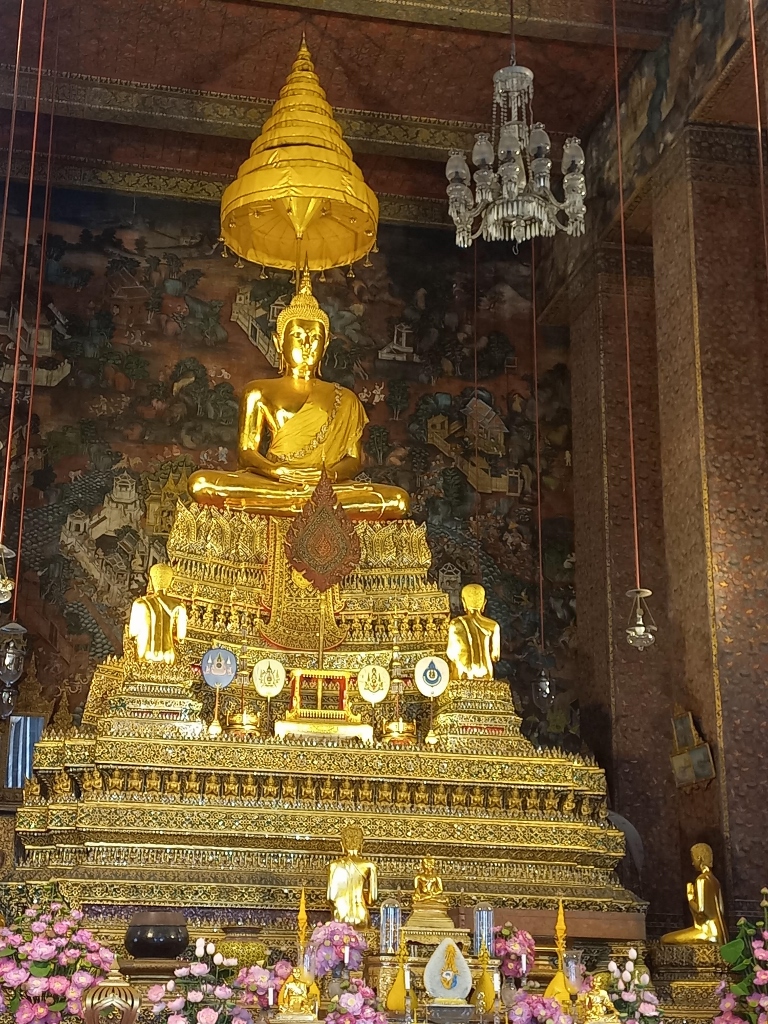 Wat Pho, the interior of the ubosot
Wat Pho, the interior of the ubosot
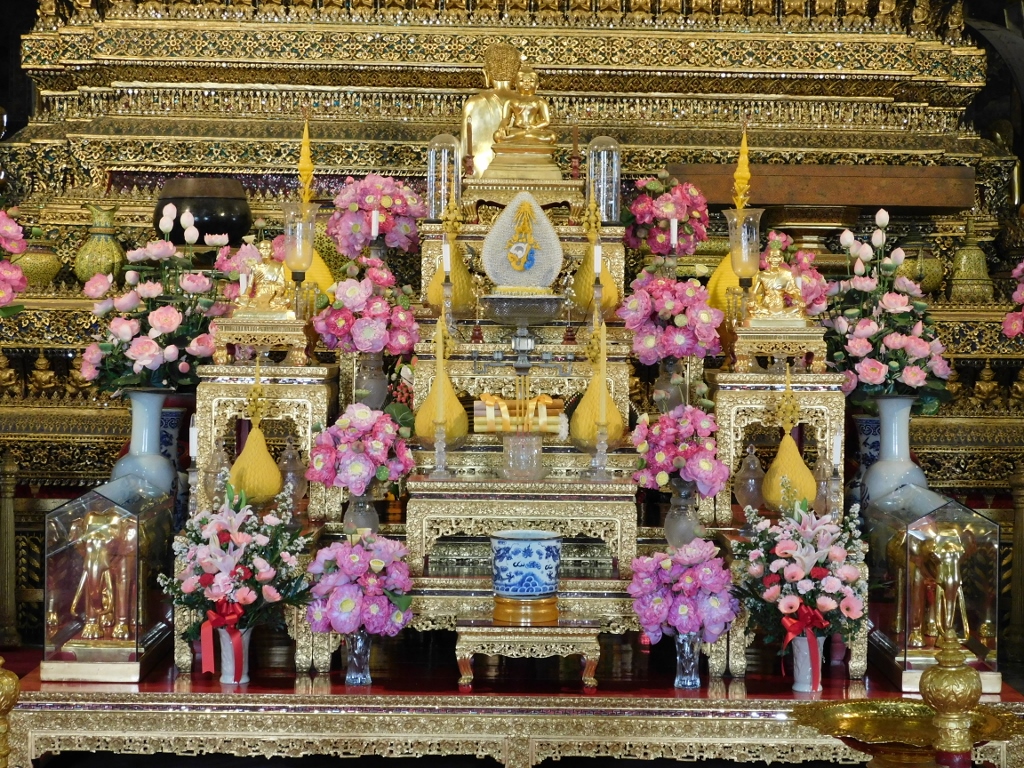 Wat Pho, the interior of the ubosot, a detail
Wat Pho, the interior of the ubosot, a detail
The ubosot is also impressive due to the murals that can be seen on the walls of the shrine and there are also decorated pillars.
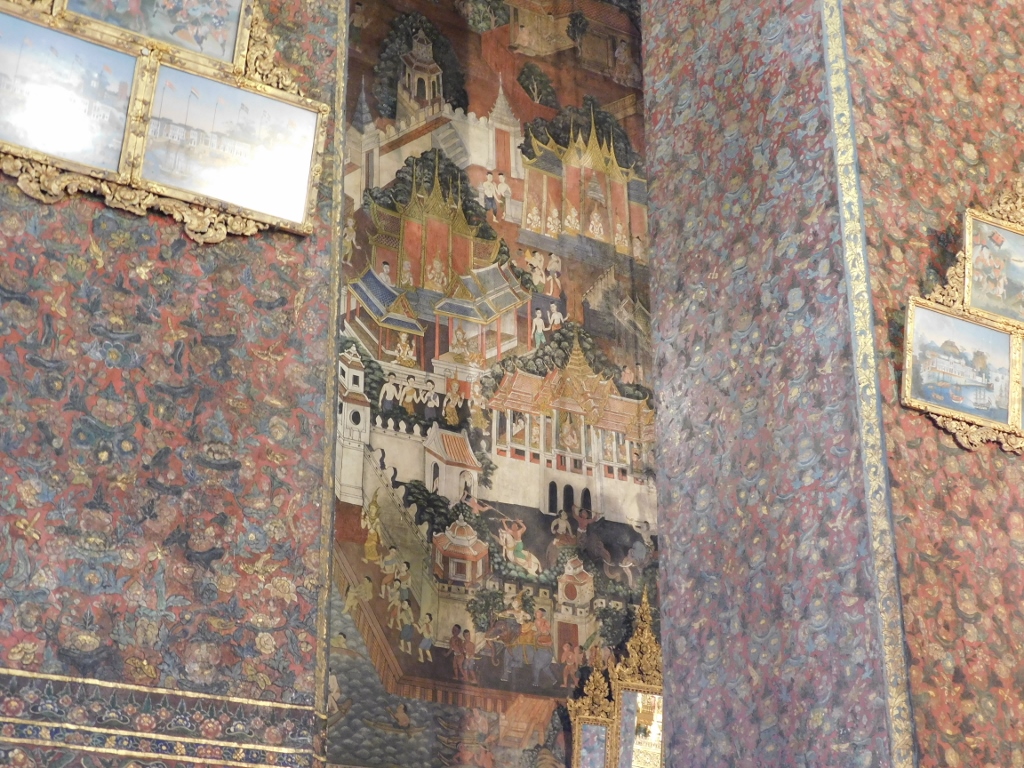 Wat Pho, the interior of the ubosot, a detail
Wat Pho, the interior of the ubosot, a detail
Then I went back out into the courtyard around the ubosot, taking photos of more details. I also noticed a beautiful bird, an oriental magpie-robin (Copsychus saularis).
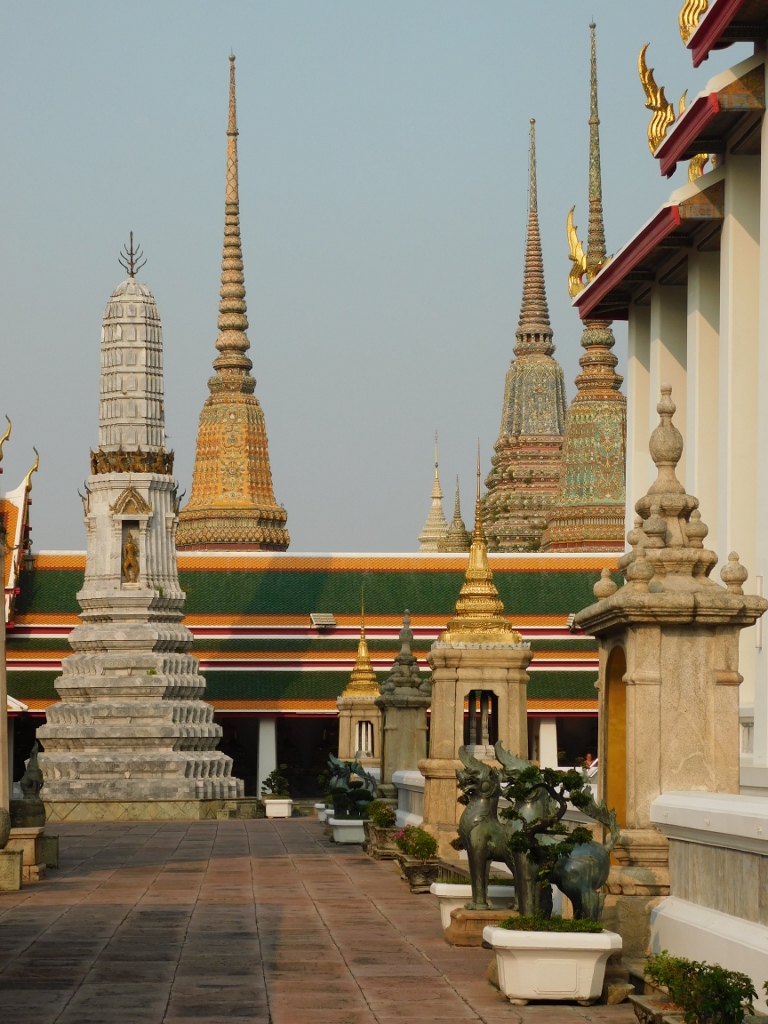 Wat Pho, a detail
Wat Pho, a detail
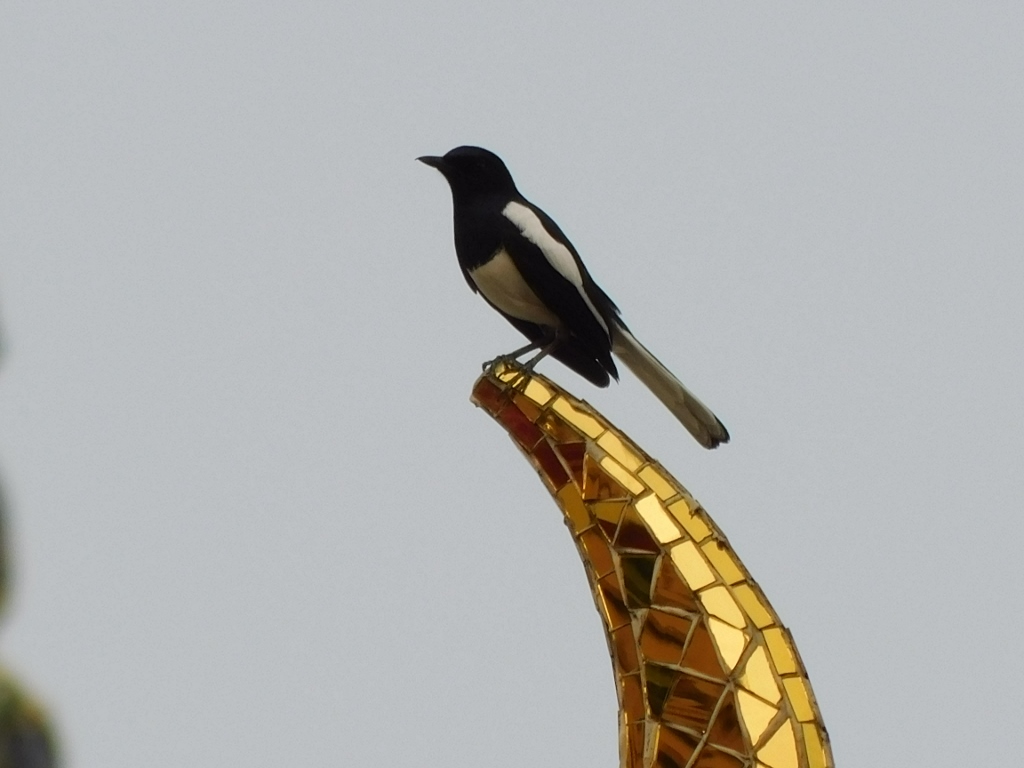 Oriental magpie-robin
Oriental magpie-robin
Behind the inner courtyard with the ubosot, there is a group of four large chedis, each standing at a height of 42 m. They are dedicated to the first four kings of the Chakri dynasty. The first three one comes across are quite similar in shape, while the one situated behind these three is slightly different.
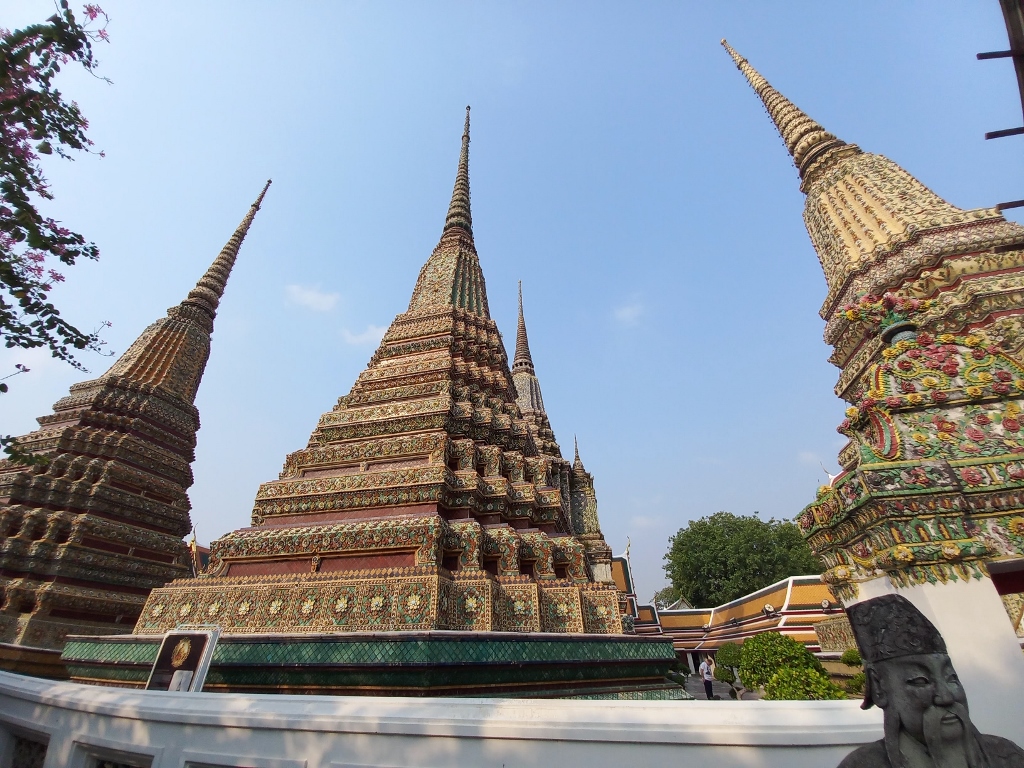 Wat Pho, a detail
Wat Pho, a detail
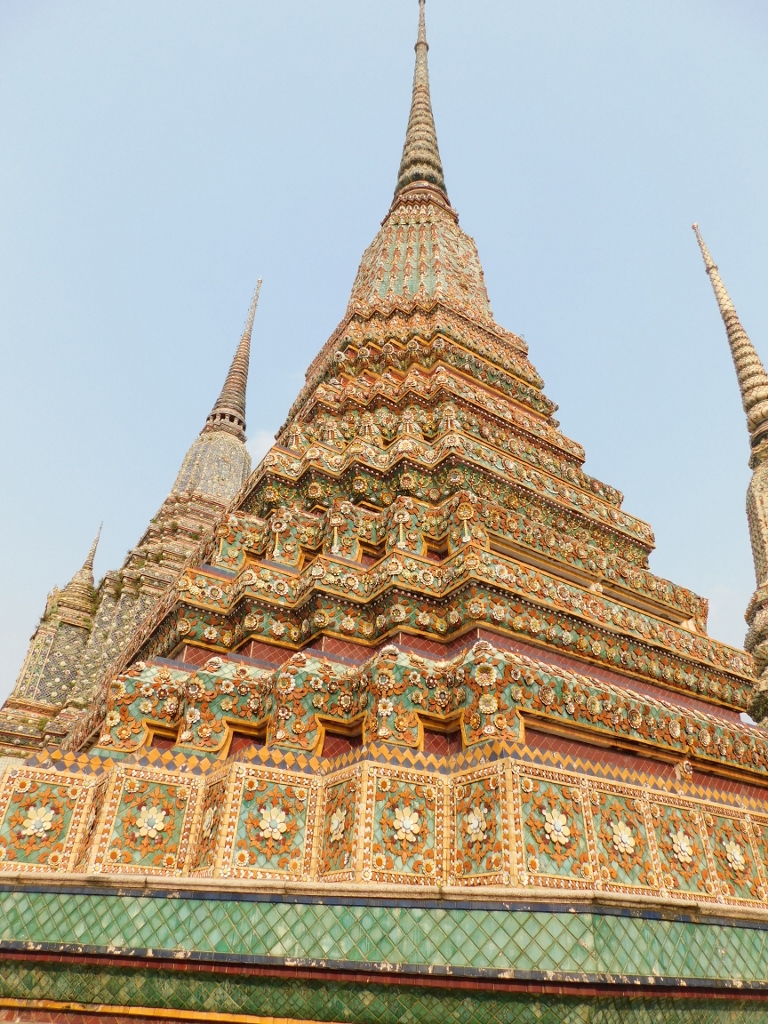 Wat Pho, a detail
Wat Pho, a detail
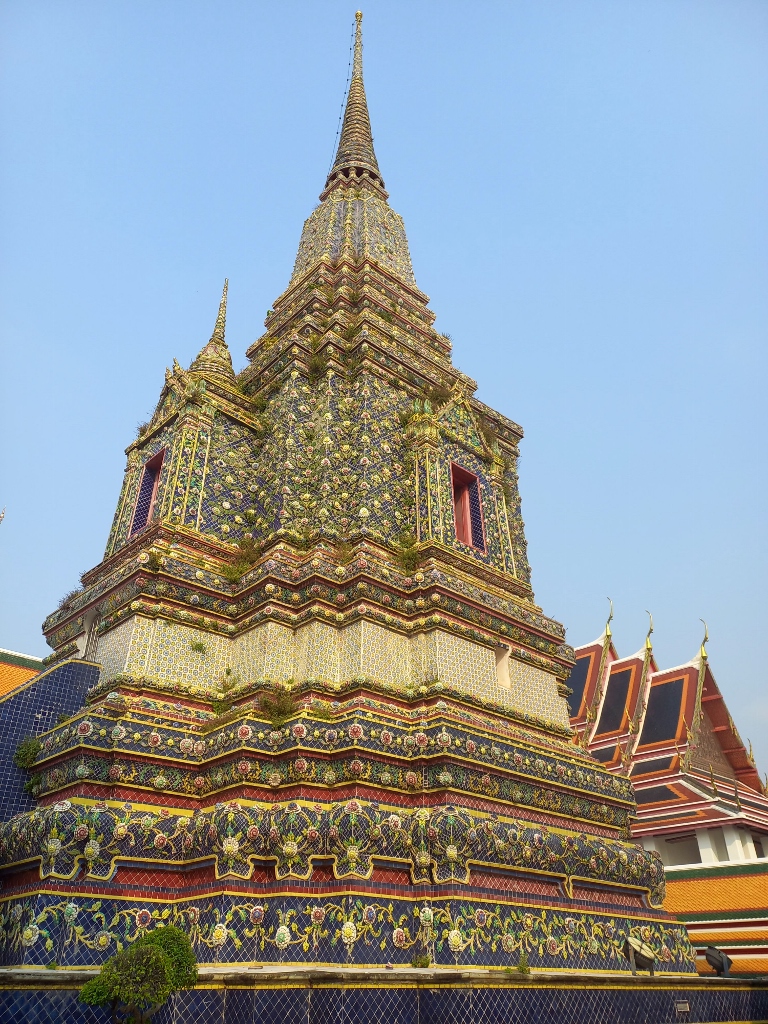 Wat Pho, a detail
Wat Pho, a detail
What was particularly impressive about them was the incredible wealth of decorative details made of glazed ceramics.
 Wat Pho, a detail
Wat Pho, a detail
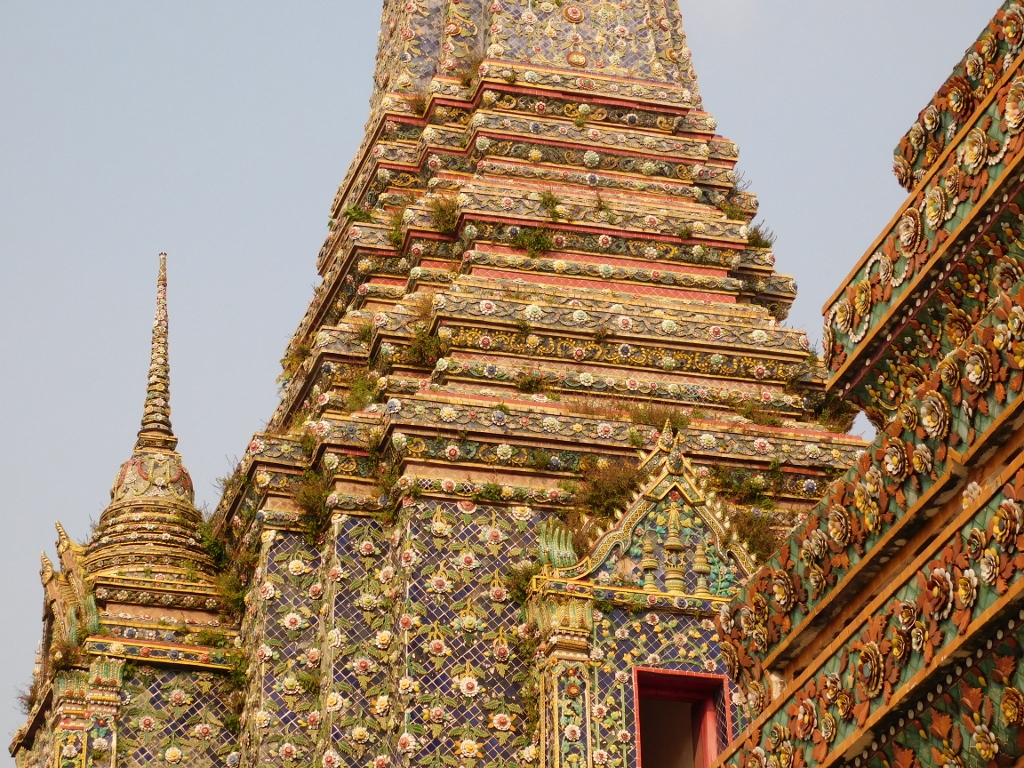 Wat Pho, a detail
Wat Pho, a detail
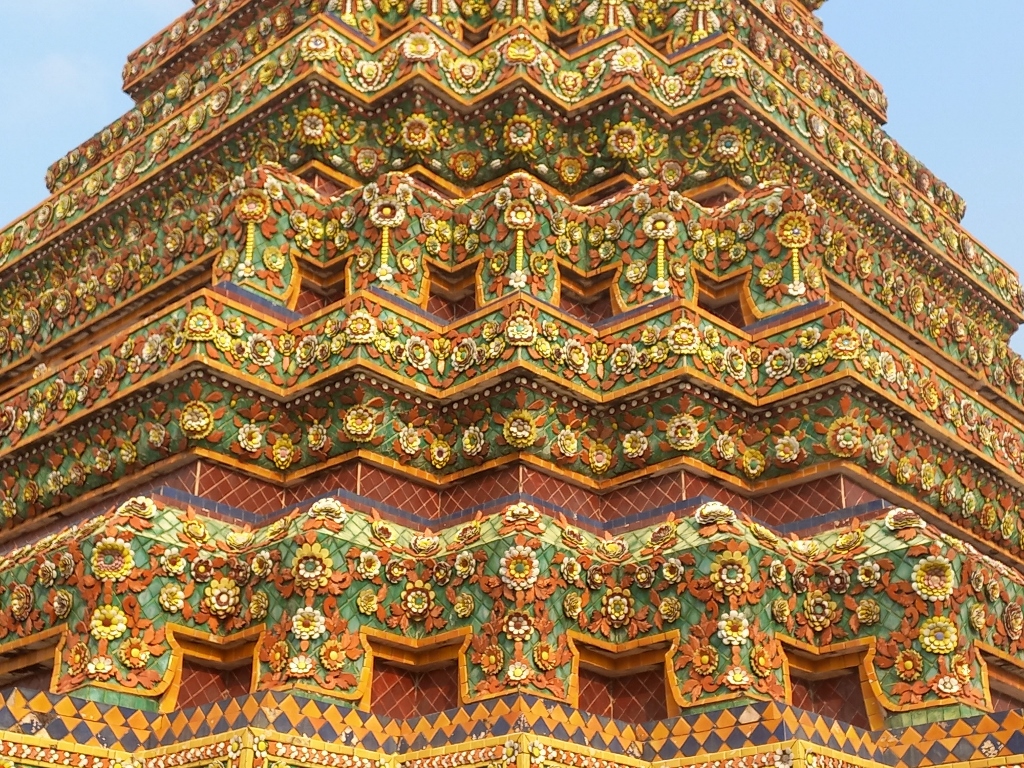 Wat Pho, a detail
Wat Pho, a detail
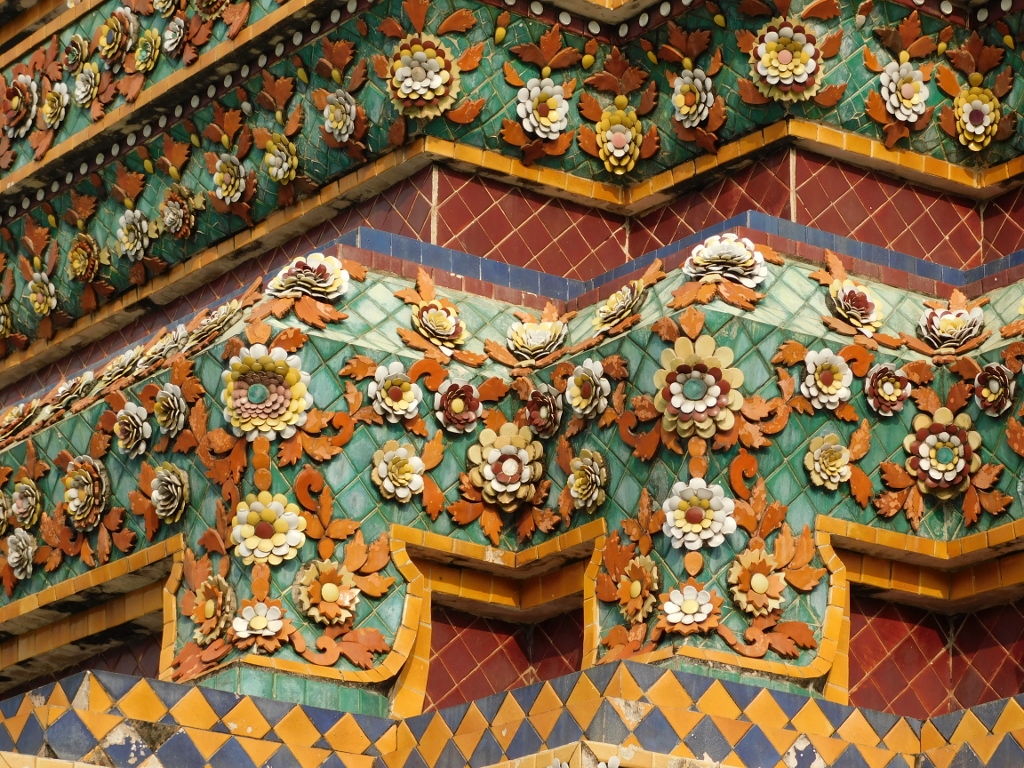 Wat Pho, a detail
Wat Pho, a detail
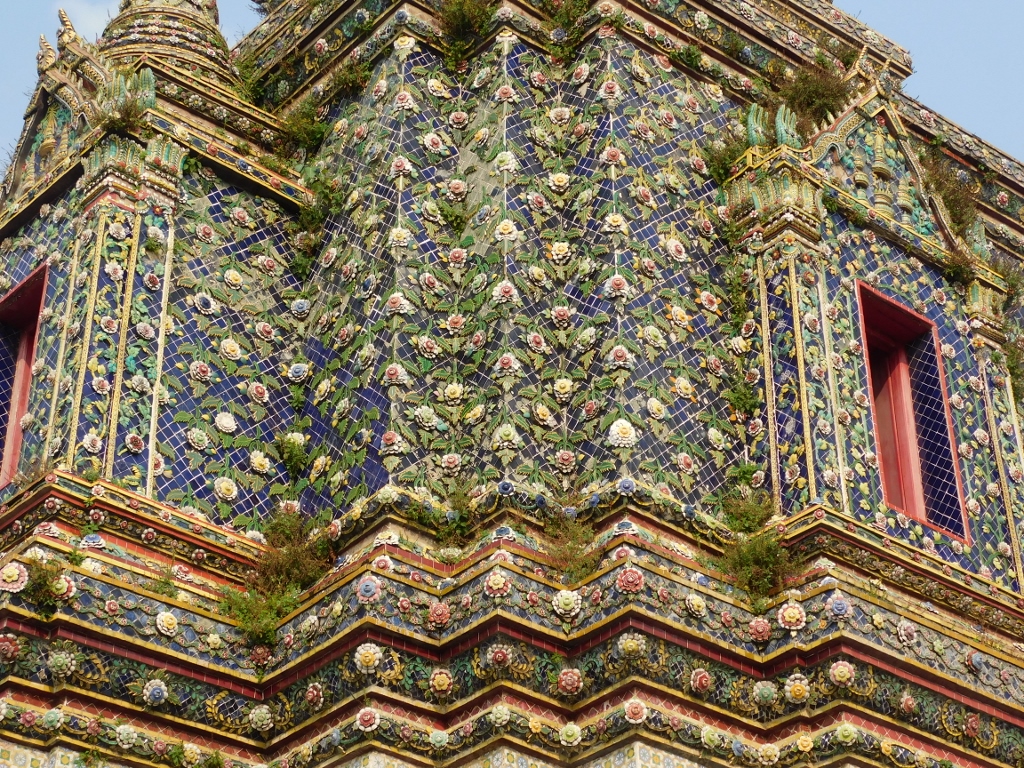 Wat Pho, a detail
Wat Pho, a detail
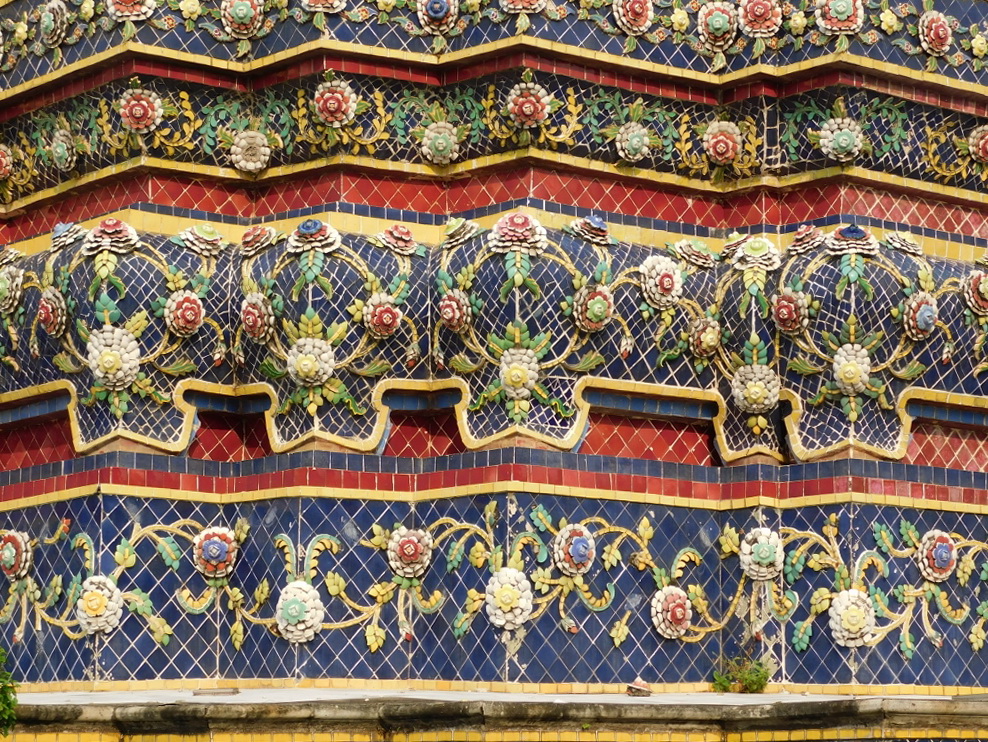 Wat Pho, a detail
Wat Pho, a detail
In the immediate vicinity of these chedis, there is a large vihara with the Reclining Buddha. Both the vihara and the Buddha were constructed in 1832 by King Rama III (b/r 1788/1824-1851).
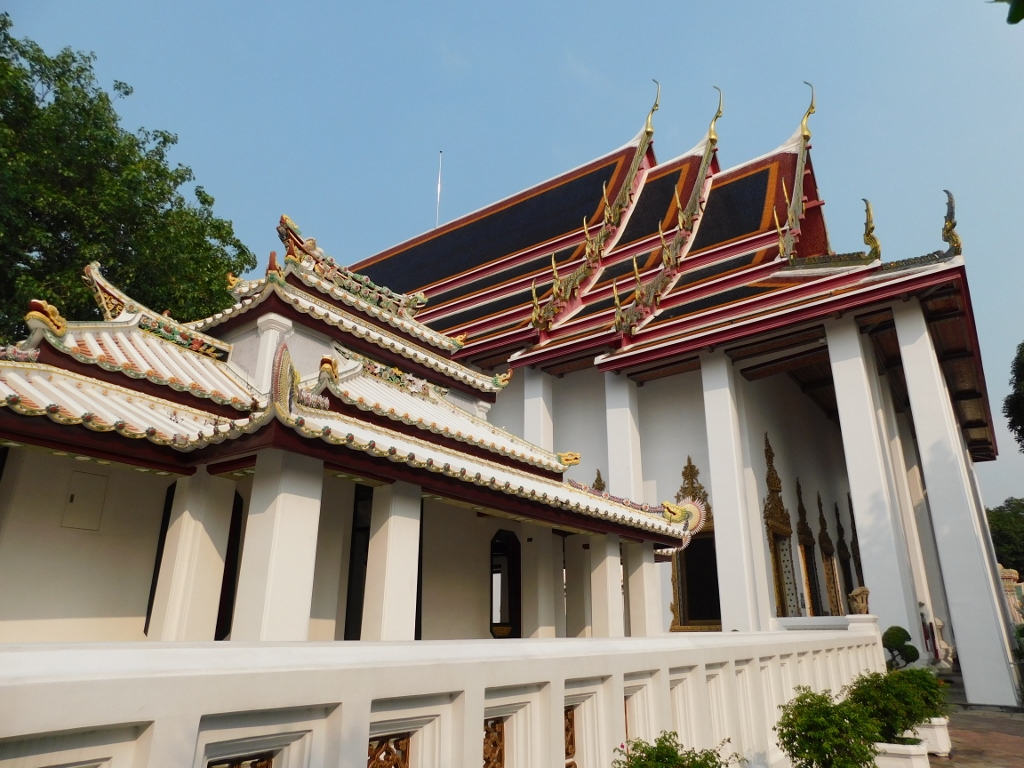 Wat Pho, vihara with the Reclining Buddha
Wat Pho, vihara with the Reclining Buddha
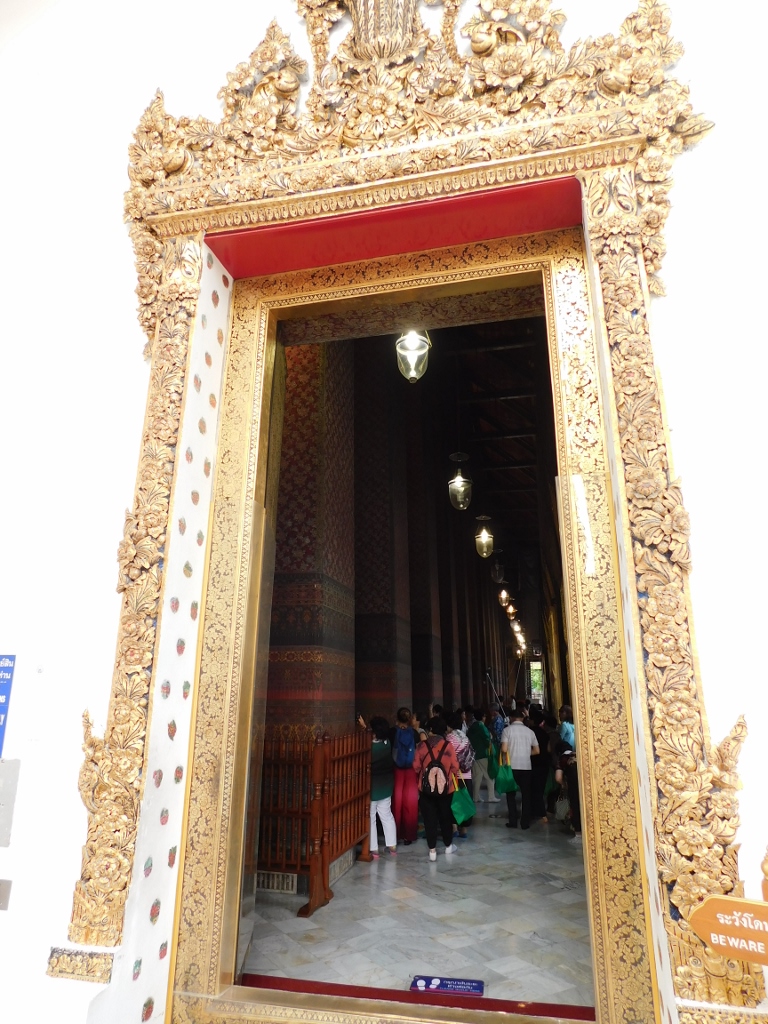 Entrance leading into the vihara
Entrance leading into the vihara
Along the middle of the vihara is this gilded statue of Buddha with impressive dimensions – it is 46 m long and 15 m high, making it the largest Reclining Buddha in the city and one of the largest in the entire country. It is quite challenging to see the entire figure of Buddha as it is not only enclosed by a fence but primarily separated from the walkway inside the vihara by massive pillars.
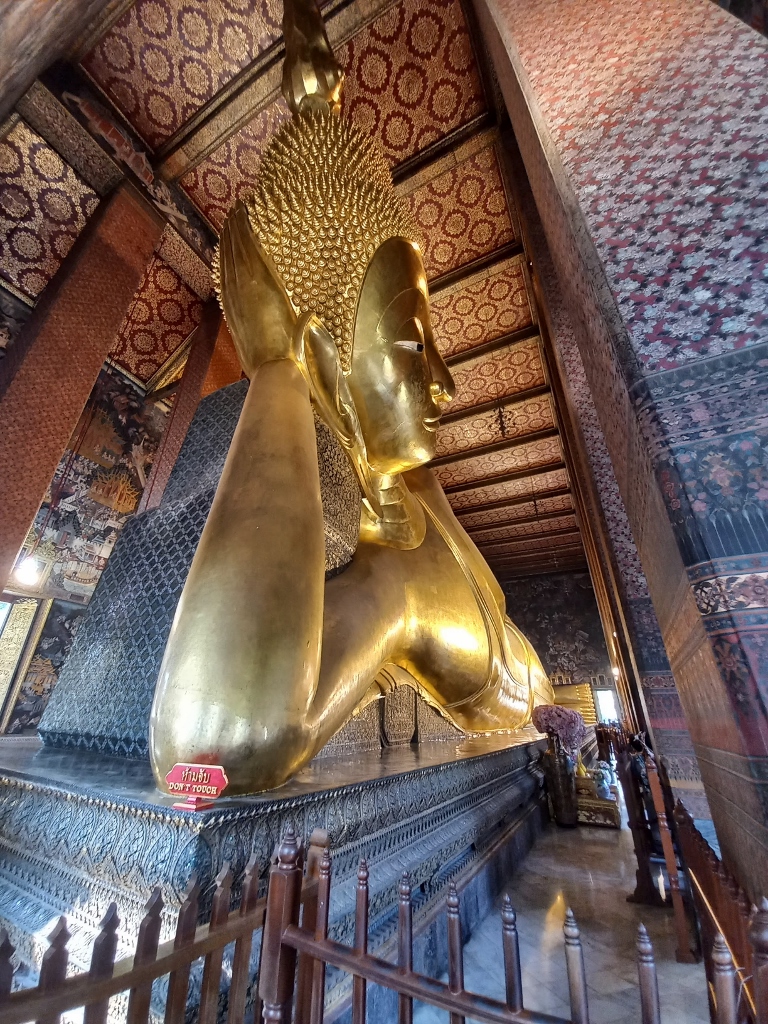 Wat Pho, the Reclining Buddha
Wat Pho, the Reclining Buddha
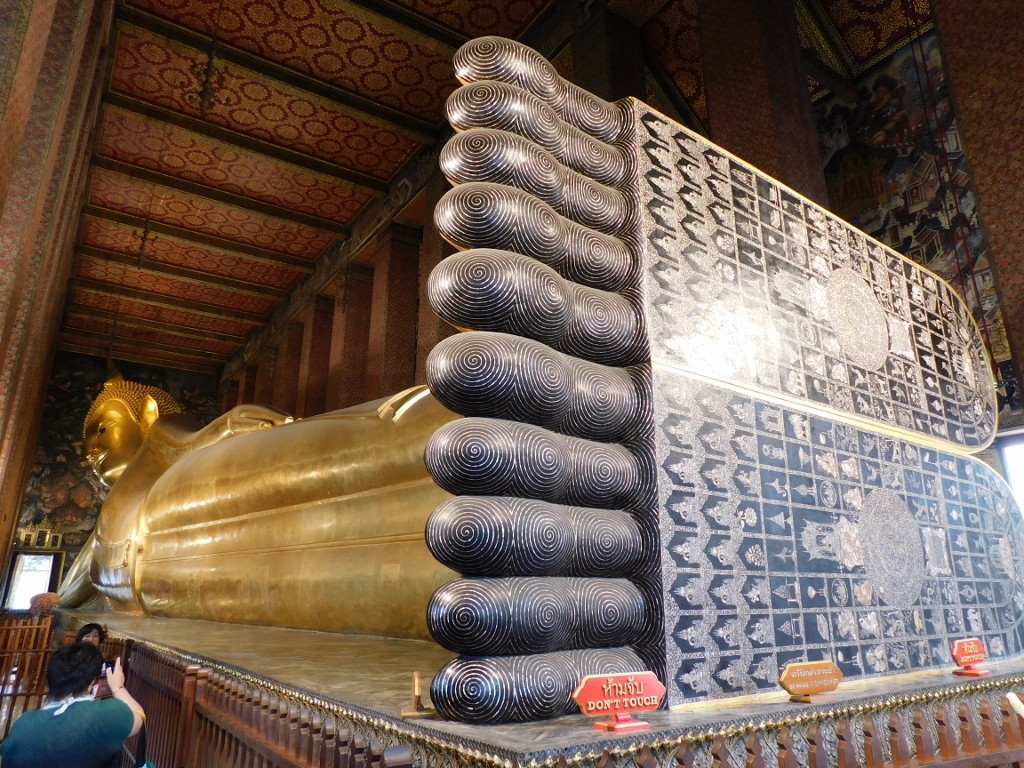 Wat Pho, the Reclining Buddha
Wat Pho, the Reclining Buddha
On the Buddha/s feet, measuring 3 x 4.5 m, there are 108 auspicious signs inlaid as intarsia. Although visitors can be captivated by the intensity of the impressions, there is also a sign (beware of pickpockets) reminding them to take care of their belongings, as not everyone who comes here has good intentions.
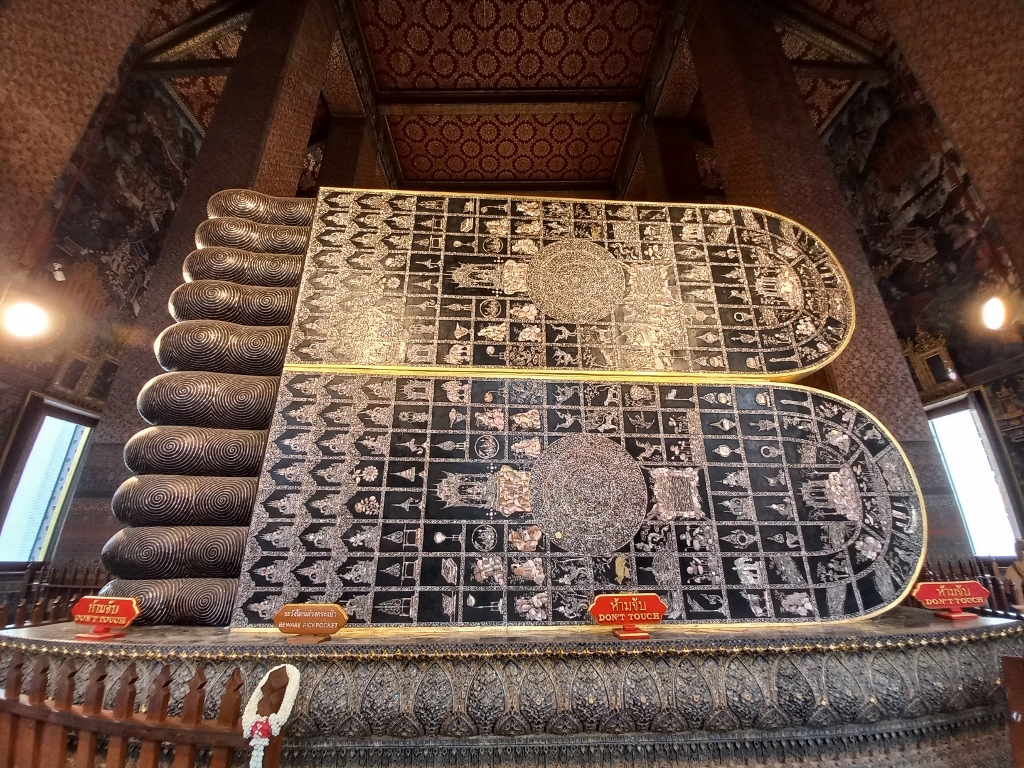 Wat Pho, the Reclining Buddha, a detail
Wat Pho, the Reclining Buddha, a detail
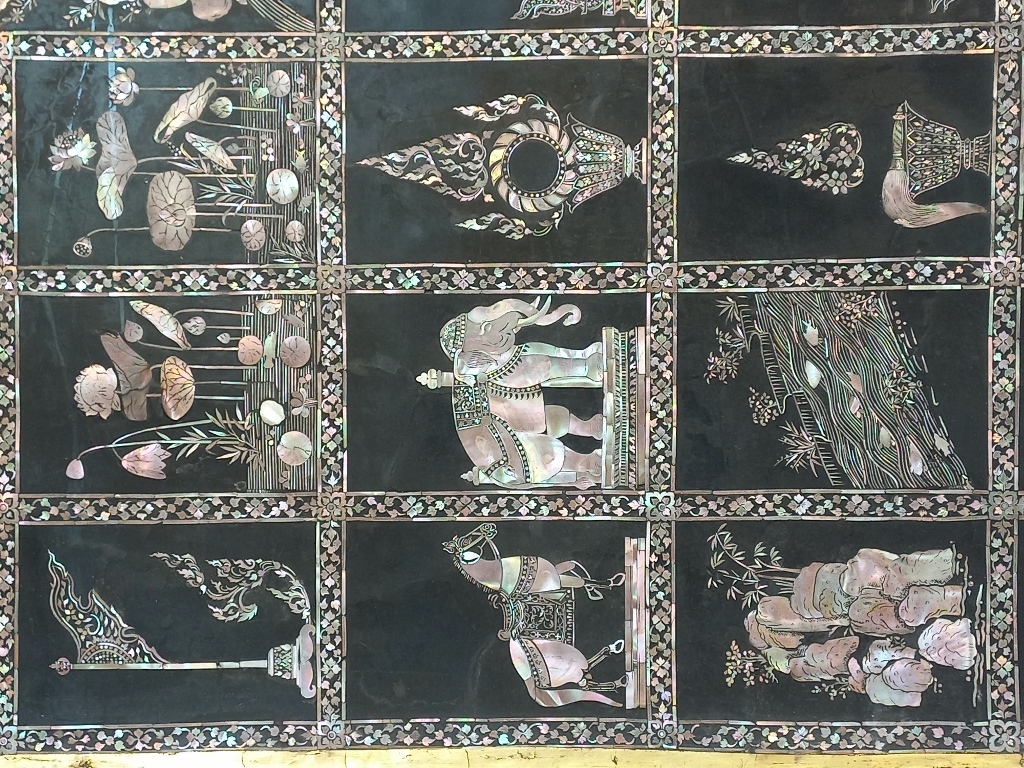 Wat Pho, the Reclining Buddha, a detail
Wat Pho, the Reclining Buddha, a detail
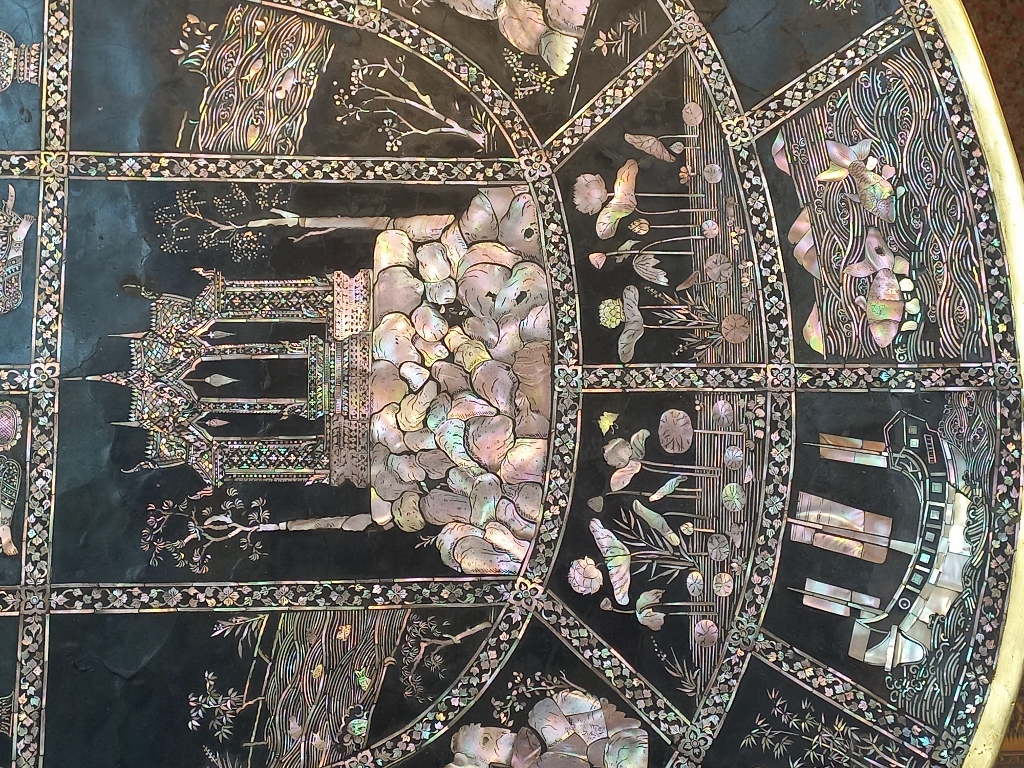 Wat Pho, the Reclining Buddha, a detail
Wat Pho, the Reclining Buddha, a detail
On the inner walls of the vihara, there are also very beautiful murals.
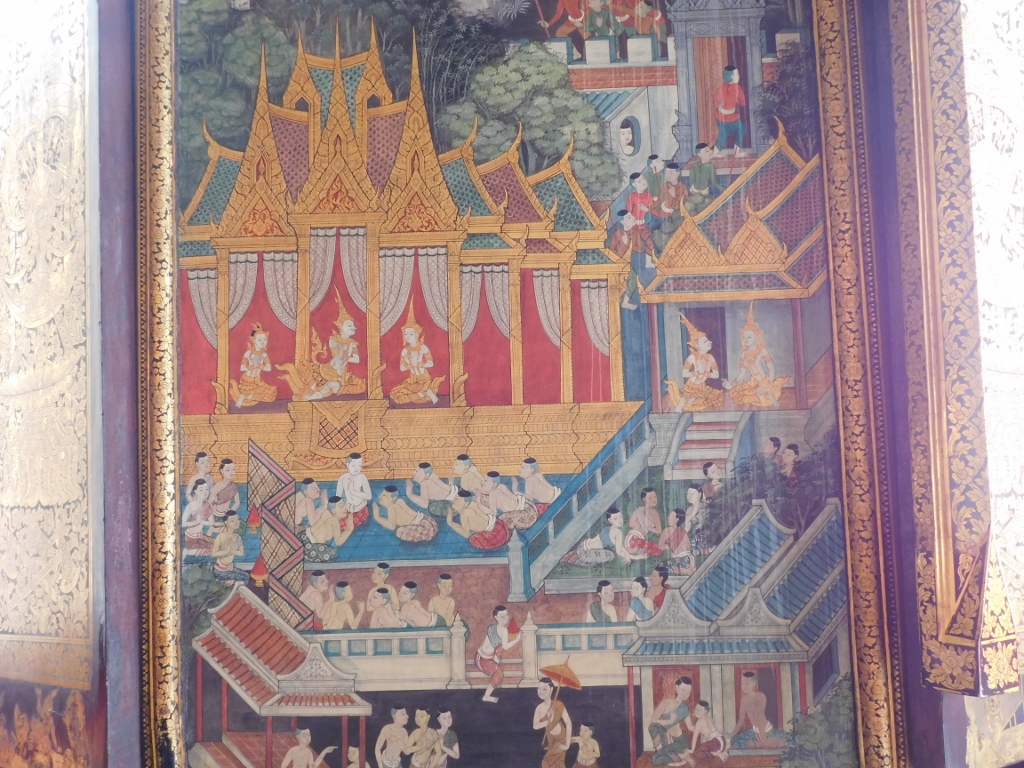 Wat Pho, Vihara of the Reclining Buddha, a detail
Wat Pho, Vihara of the Reclining Buddha, a detail
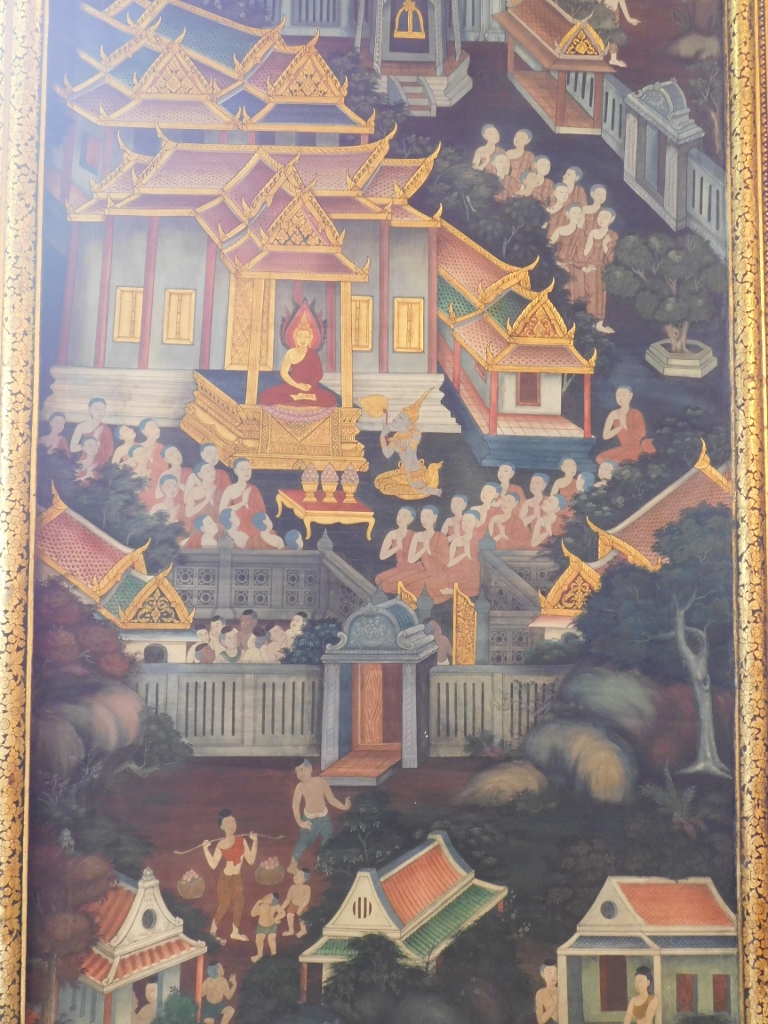 Wat Pho, Vihara of the Reclining Buddha, a detail
Wat Pho, Vihara of the Reclining Buddha, a detail
However, there is something very interesting here, although it is related to serious religion. In the passage behind the Buddha’s back, 108 bronze bowls are placed where visitors are supposed to throw coins, as it is believed to bring them luck. Since visitors usually don’t have 108 coins with them, the issue is resolved by paying a girl for a bowl with small coins and then these coins are thrown into these bowls along the wall.
 Wat Pho, Vihara of the Reclining Buddha, a detail
Wat Pho, Vihara of the Reclining Buddha, a detail
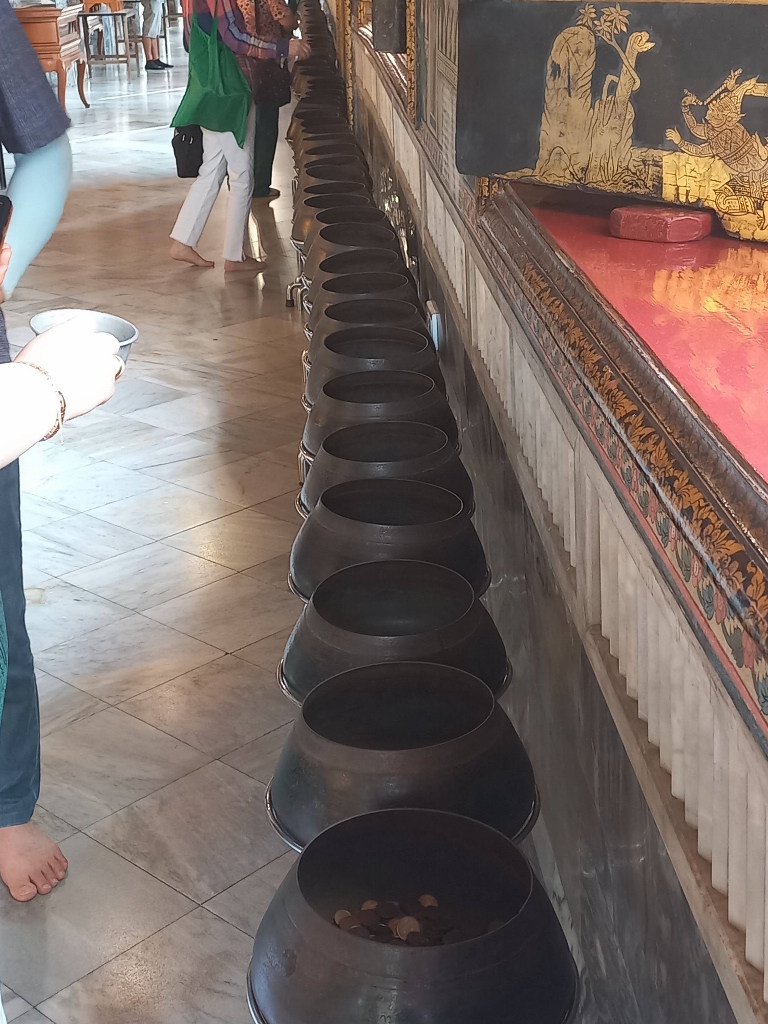 Wat Pho, Vihara of the Reclining Buddha, a detail
Wat Pho, Vihara of the Reclining Buddha, a detail
Of course, I had to do this and I had to capture it in video format. Here it is, but let me clarify my initial words – the first part of the recording somehow got interrupted or I didn’t press something correctly.
Before leaving the vihara, I recorded the Reclining Buddha once again, but from the back, showcasing the curls on his head, as well as the pedestal supporting his head.
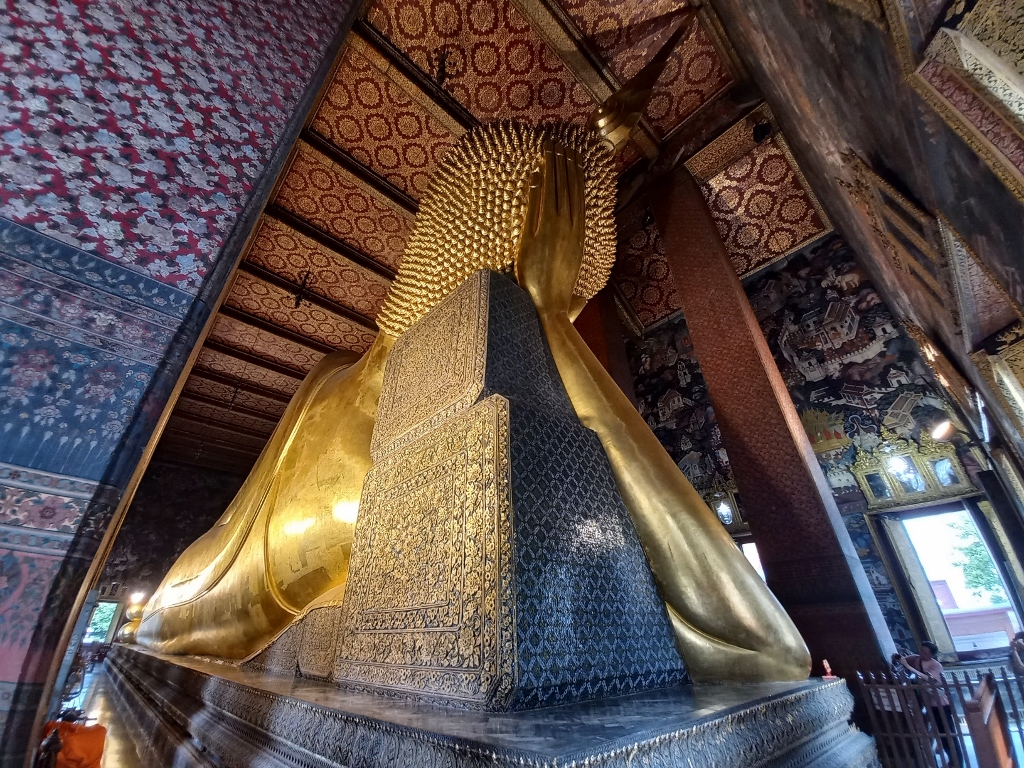 Wat Pho, the Reclining Buddha
Wat Pho, the Reclining Buddha
While walking through the rear part of the temple complex, I also reached the mondop where the temple library with Buddhist sacred scriptures is located. It is not open to the public, but its exterior is equally impressive and elegantly decorated.
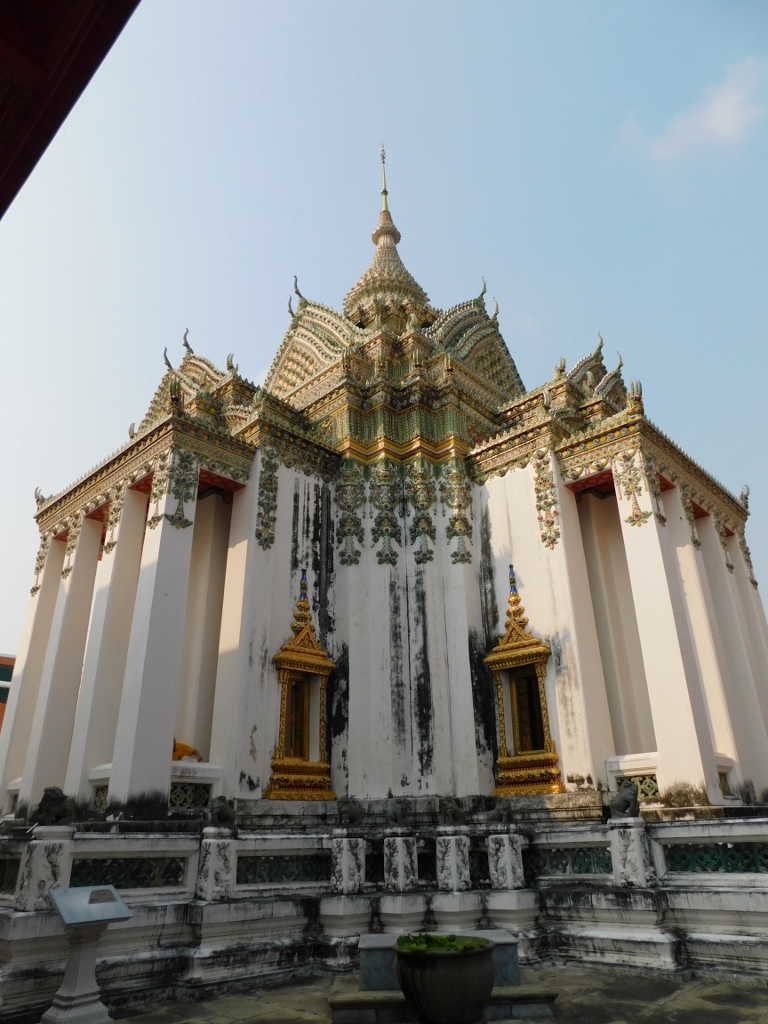 Wat Pho, Phra Mondop
Wat Pho, Phra Mondop
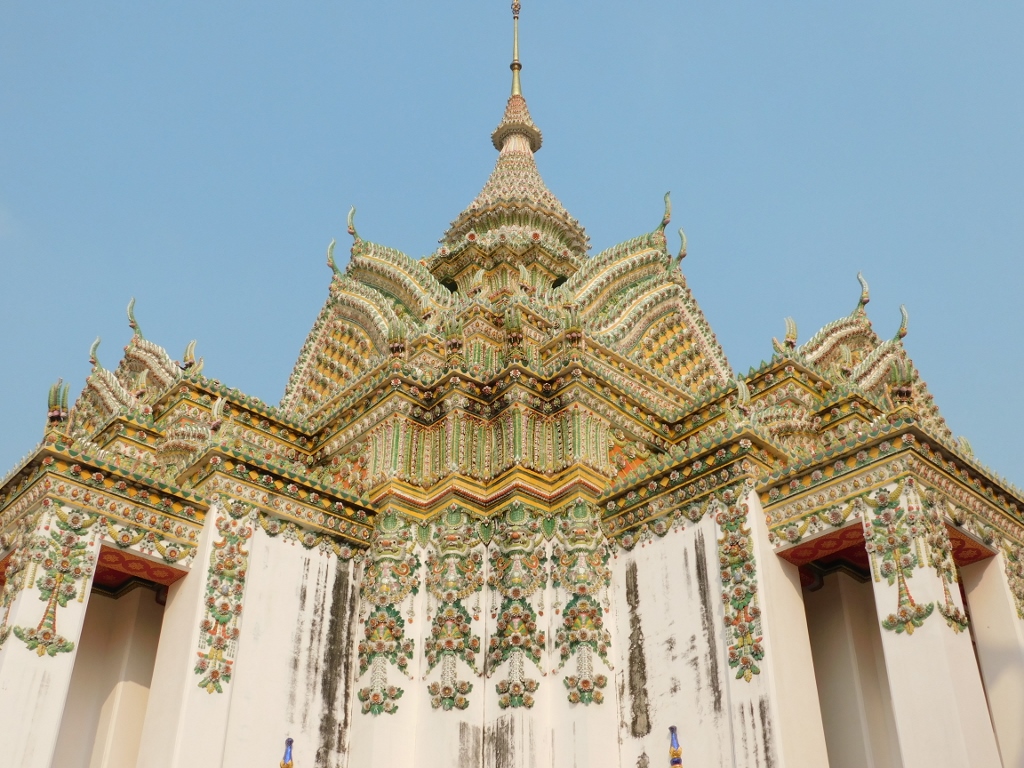 Wat Pho, Phra Mondop
Wat Pho, Phra Mondop
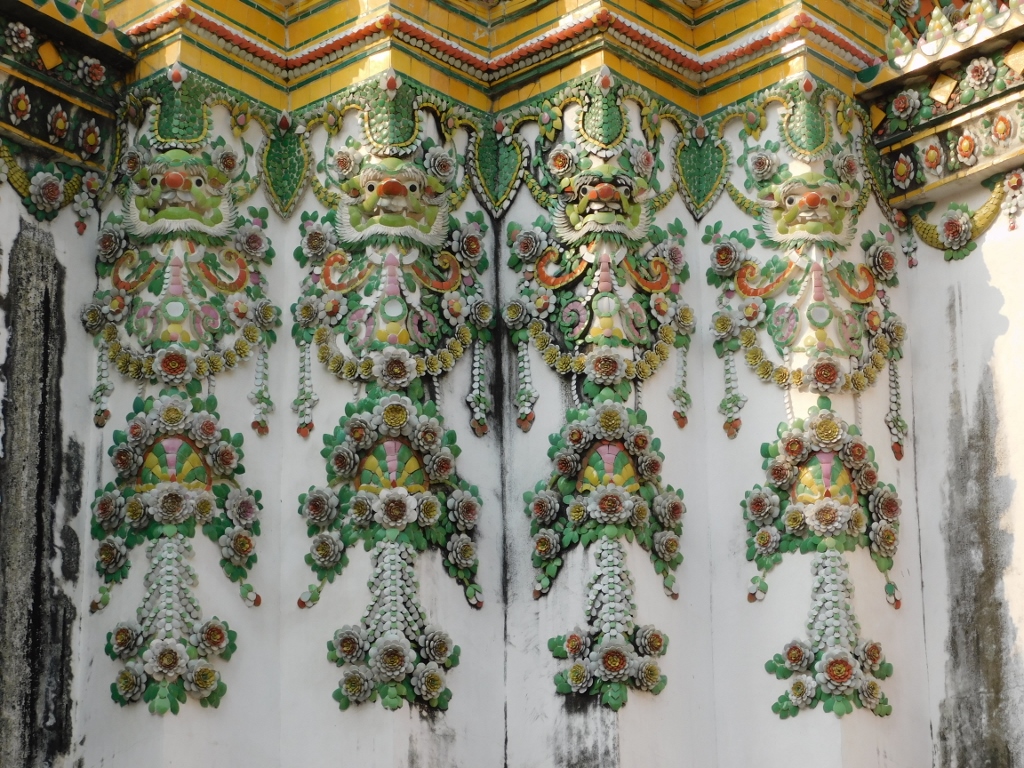 Wat Pho, Phra Mondop, a detail
Wat Pho, Phra Mondop, a detail
At several locations within the temple complex, sculptures of hermits in various yoga positions, including positions used in Thai massage, can be seen. I might even achieve enlightenment in some life, but some of these positions – never.
 Wat Pho, a detail
Wat Pho, a detail
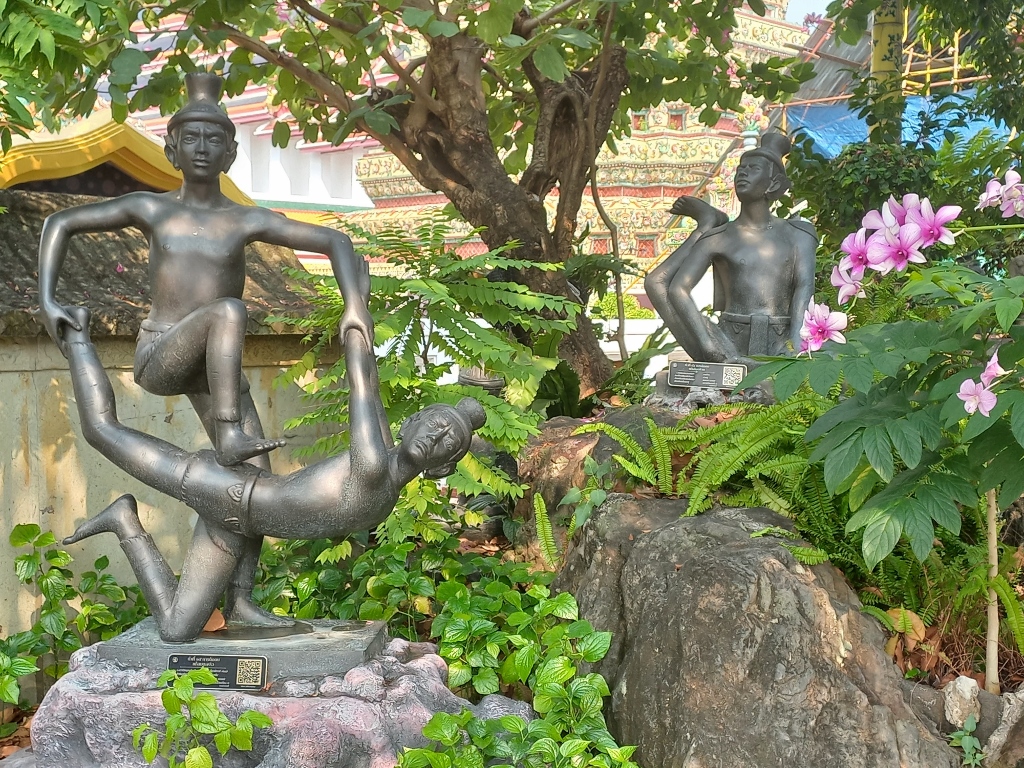 Wat Pho, a detail
Wat Pho, a detail
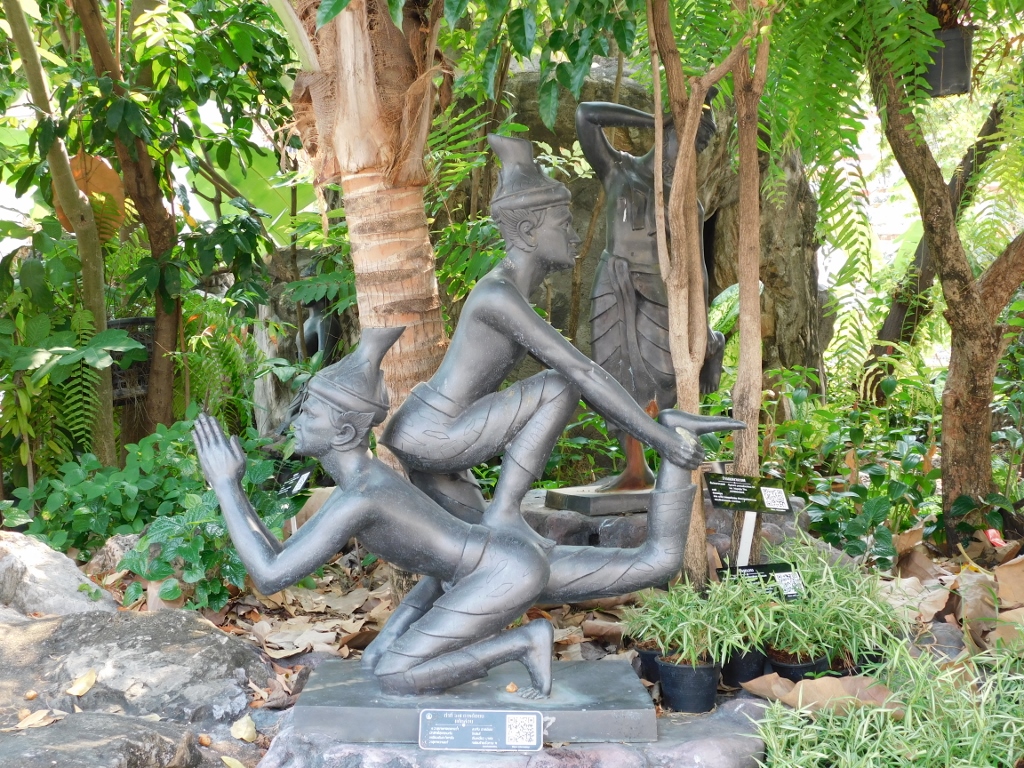 Wat Pho, a detail
Wat Pho, a detail
These sculptures within a temple should not be surprising at all, as Wat Pho is also the most important national centre for traditional medicine, which includes Thai massage. There are a couple of pavilions within the temple where Thai massage can be studied and practiced. In addition, there is a museum here dedicated to traditional Thai massage since this form of massage, primarily used for healing, is recognised as intangible cultural heritage by the UNESCO.
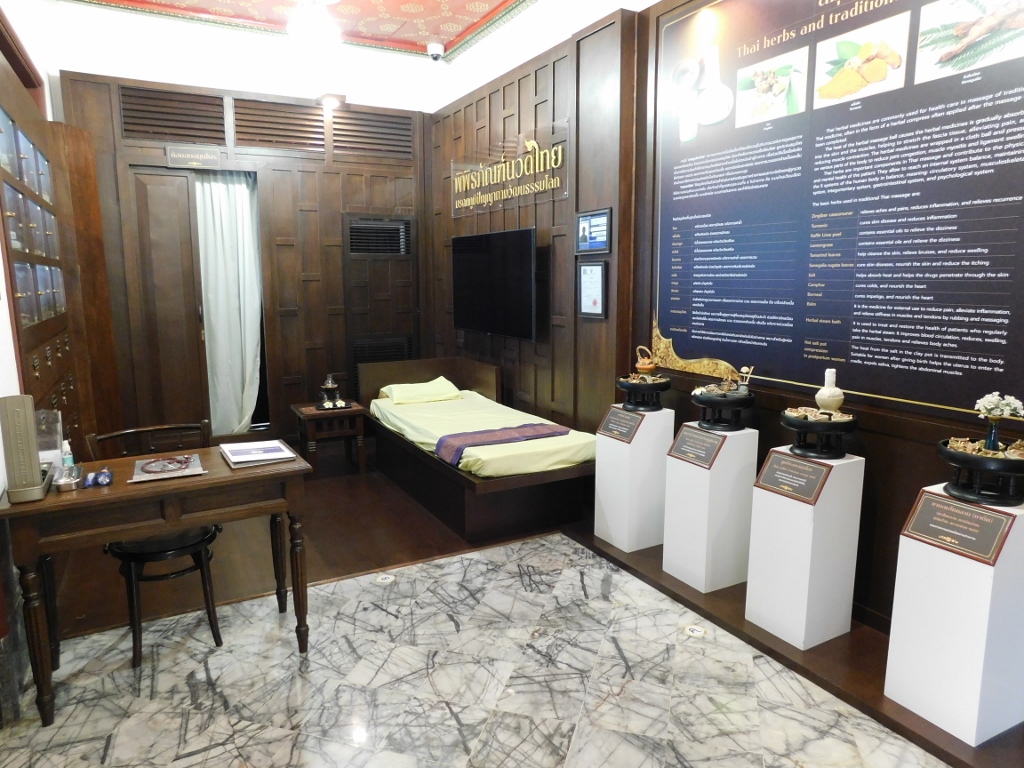 Wat Pho, the museum
Wat Pho, the museum
In the small, yet well-organised museum, various exhibits can be seen along with information boards detailing the history of Thai massage, the medicinal herbs used, the standards that must be followed, the energy flows within the human body, the impact of the four traditional elements on health and the influence of the Buddhist principles embedded in the foundations of both traditional Thai medicine and the traditional Thai massage as one of its integral parts.
After the museum visit, I continued to explore the temple complex, which is full with an incredible array of details. I also entered some viharas and there I saw Buddha statues, but while just walking amid the various parts of the temple – walls, pavilions and chedis – I didn’t know where to look first. Everything was extremely picturesque.
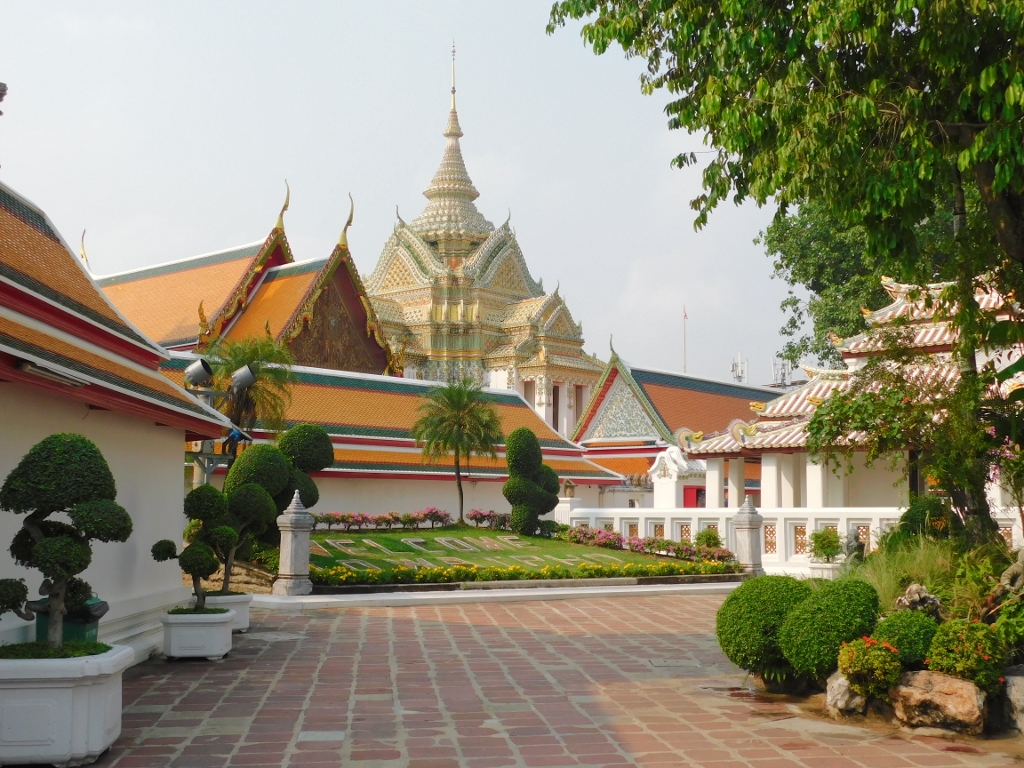 Wat Pho, a detail
Wat Pho, a detail
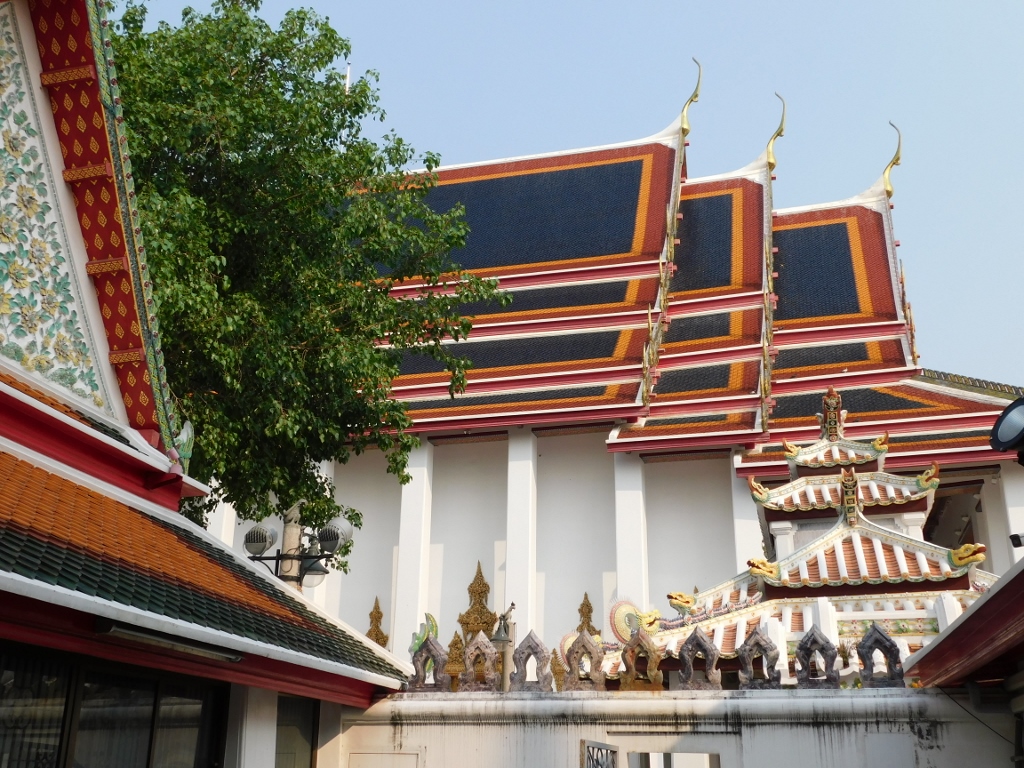 Wat Pho, a detail
Wat Pho, a detail
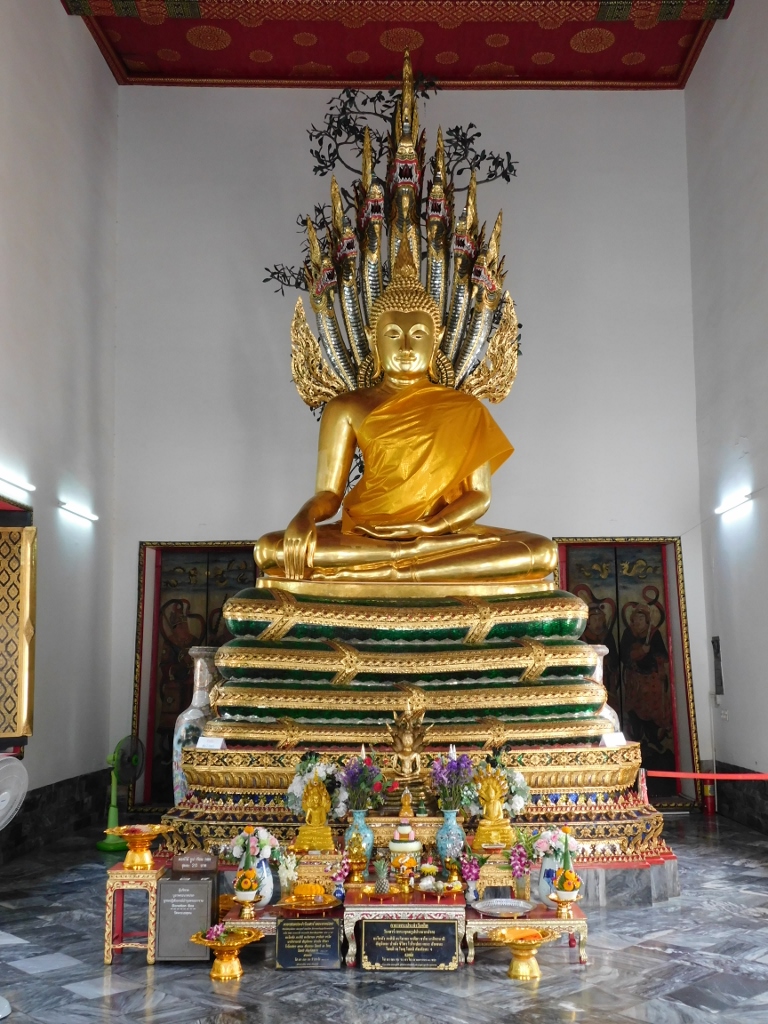 Wat Pho, Sitting Buddha in the west vihara
Wat Pho, Sitting Buddha in the west vihara
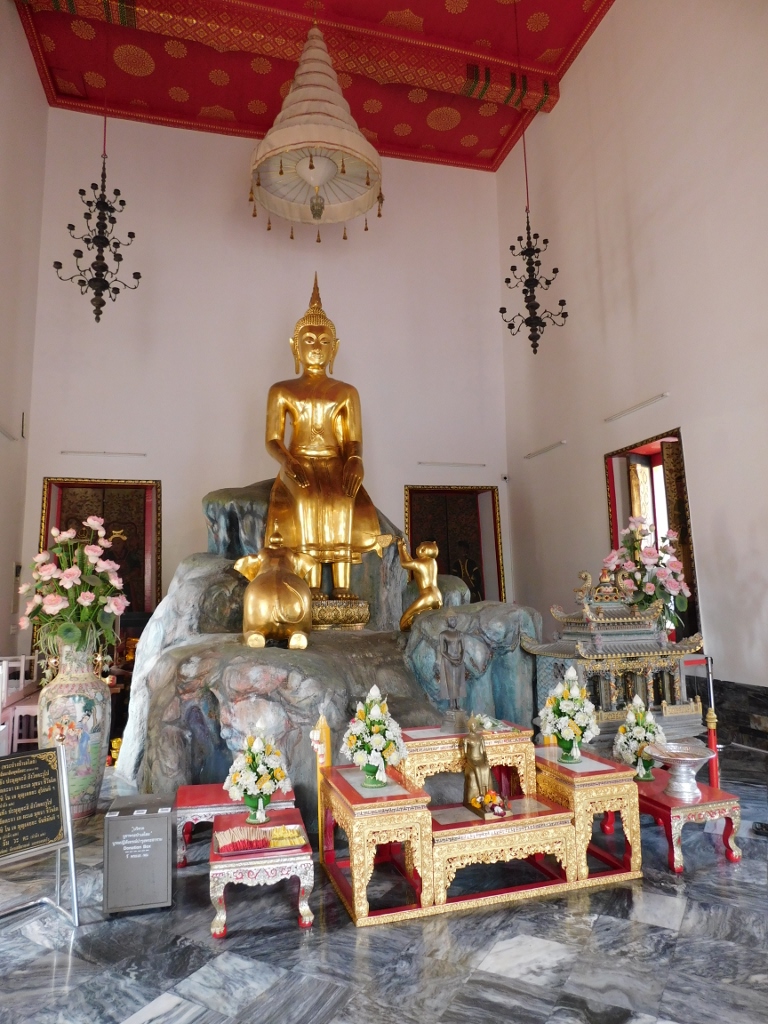 Wat Pho, Sitting Buddha in the north vihara
Wat Pho, Sitting Buddha in the north vihara
I was particularly intrigued by the Buddha Palilai, located in the northern vihara, seated on a rock in a posture of accepting offerings, accompanied by an elephant and a monkey presenting offerings to him.
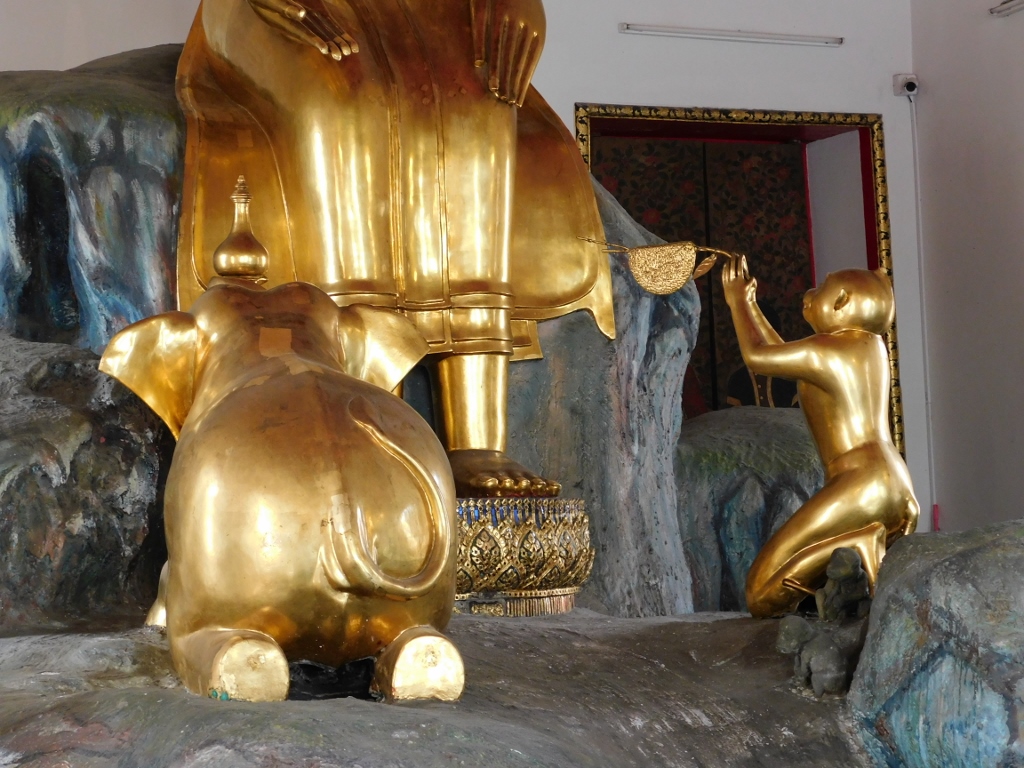 Wat Pho, the north vihara, a detail
Wat Pho, the north vihara, a detail
Now, I headed towards the exit, continuing to admire the picturesque elements of the temple and capturing them with my camera along the way.
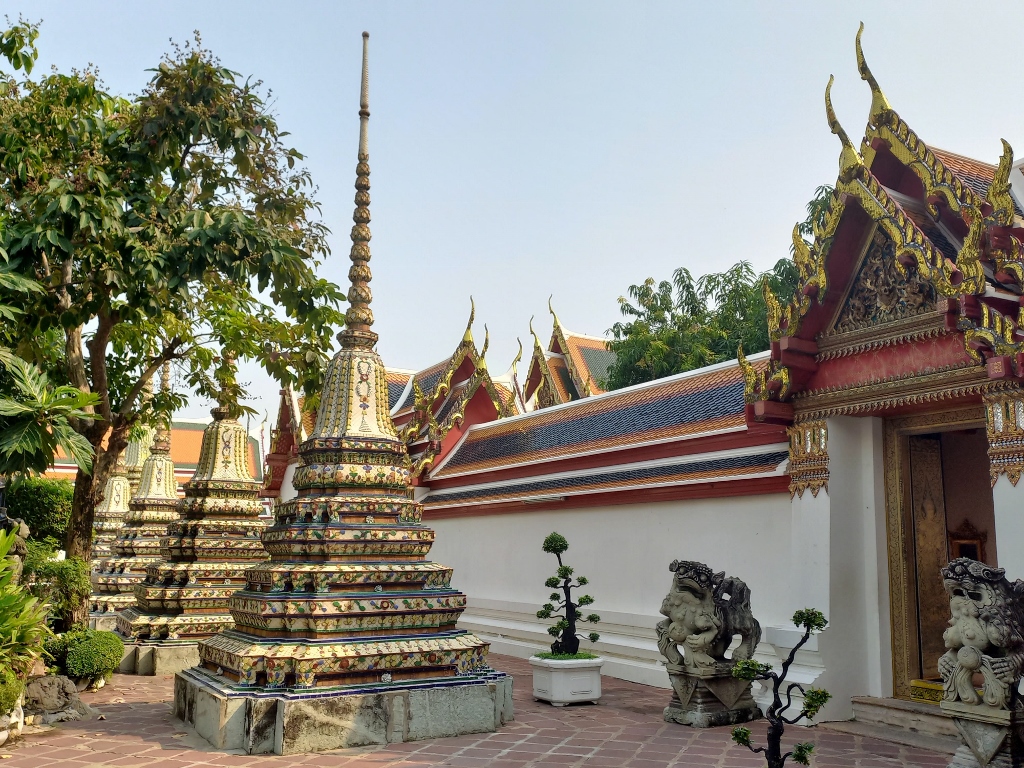 Wat Pho, a detail
Wat Pho, a detail
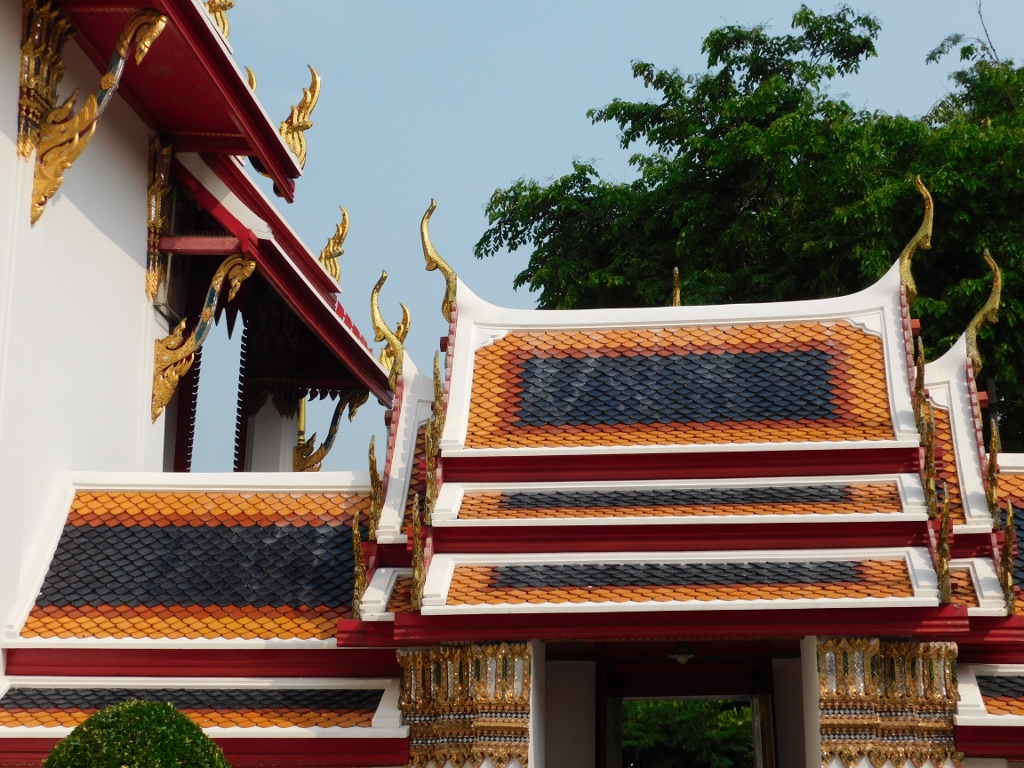 Wat Pho, a detail
Wat Pho, a detail
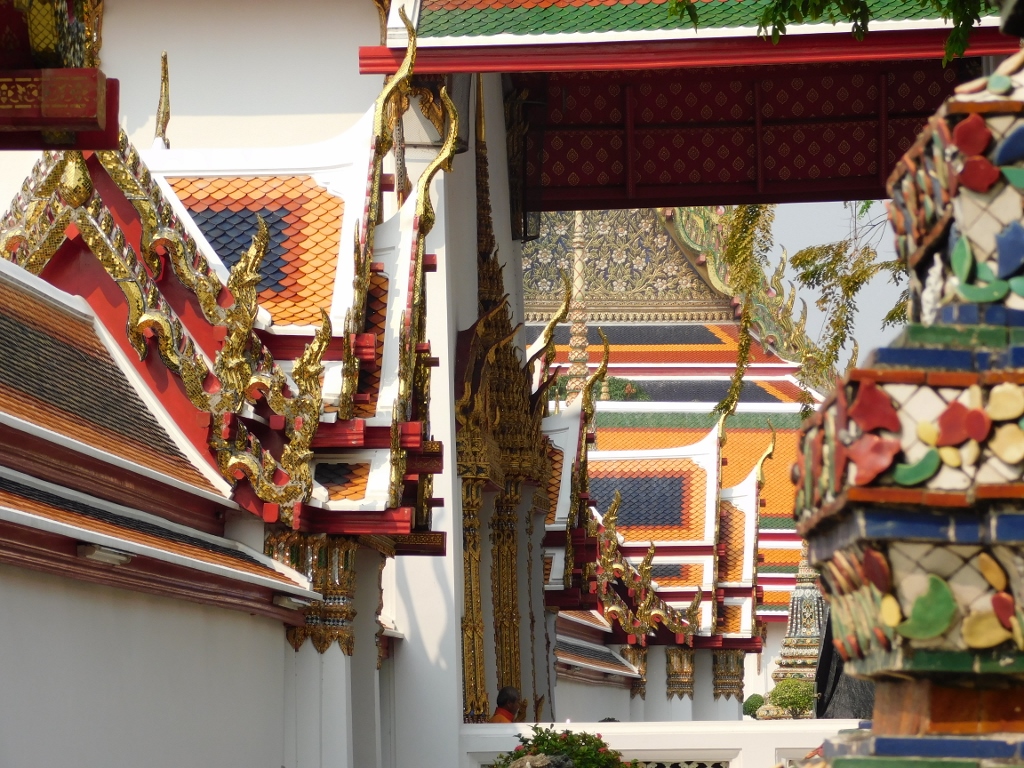 Wat Pho, a detail
Wat Pho, a detail
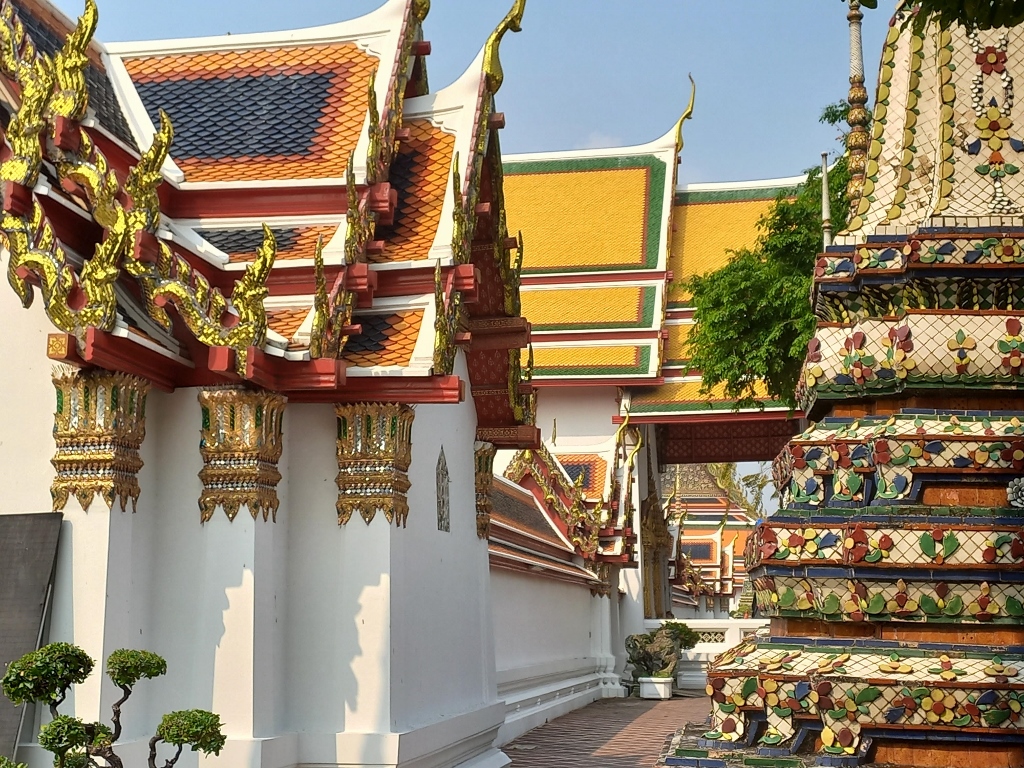 Wat Pho, a detail
Wat Pho, a detail
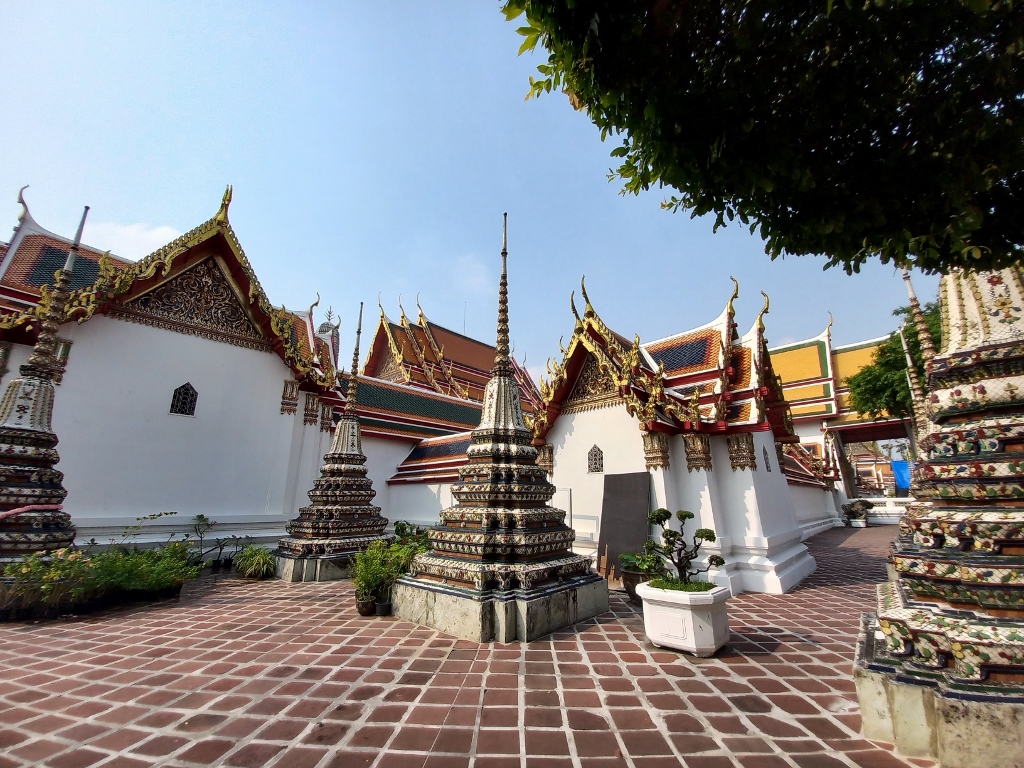 Wat Pho, a detail
Wat Pho, a detail
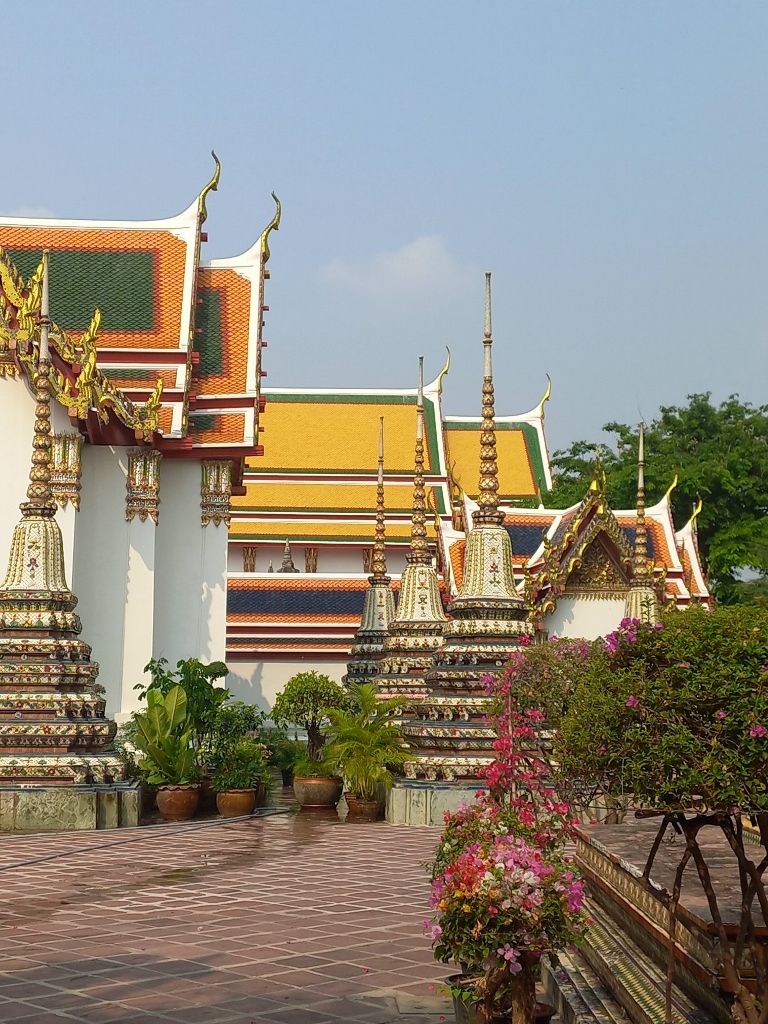 Wat Pho, a detail
Wat Pho, a detail
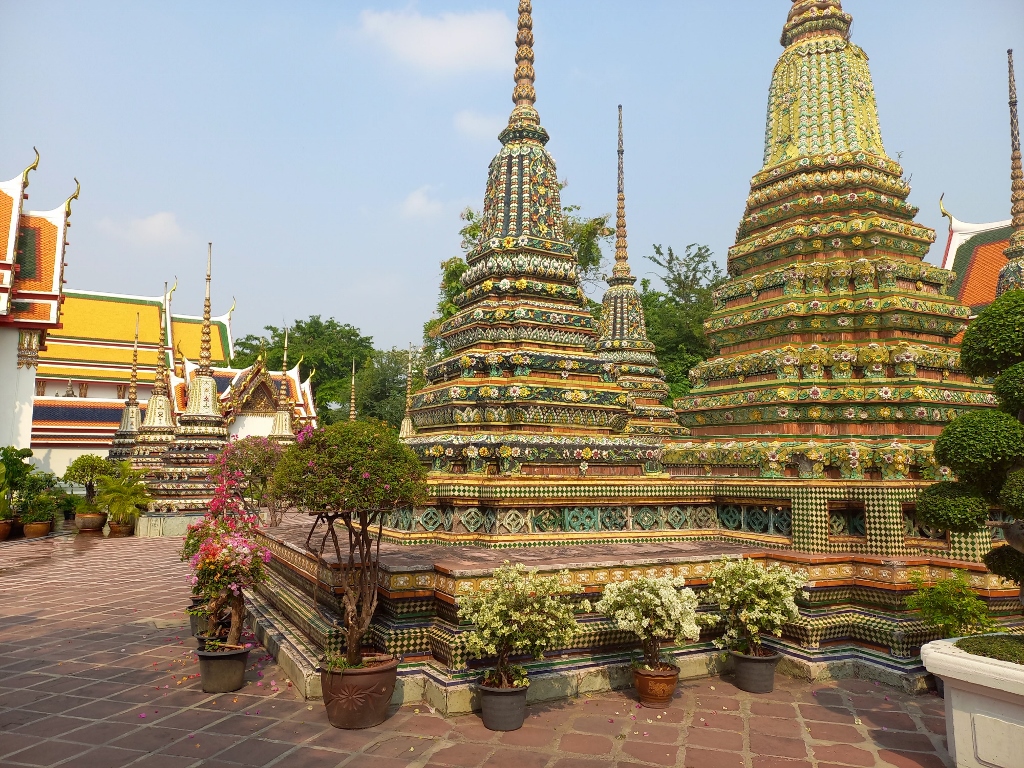 Wat Pho, a detail
Wat Pho, a detail